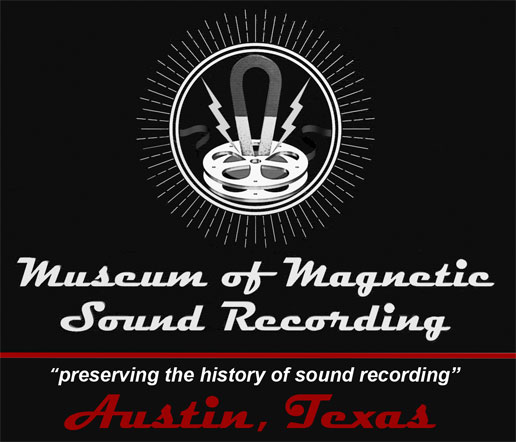Tandberg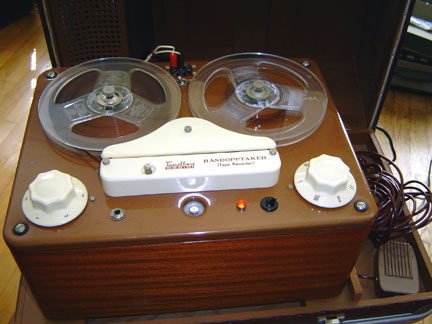
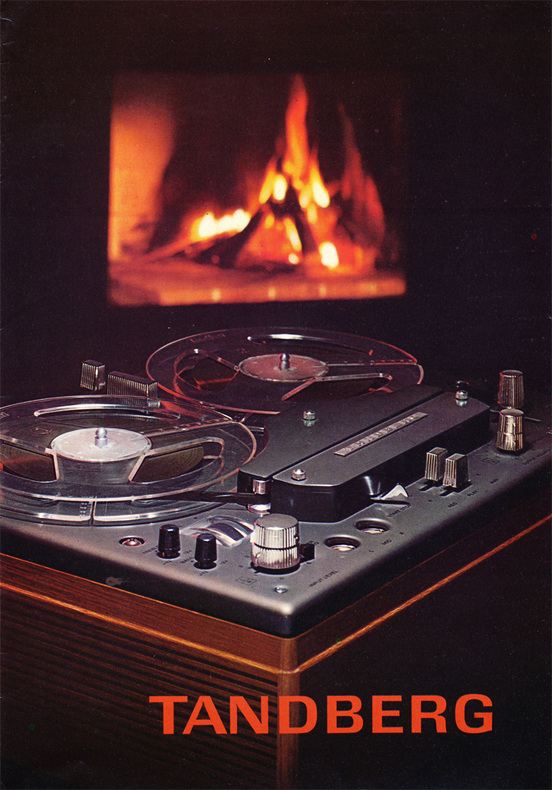
Tandberg, Lysaker, Norway
Founded in 1933 by Vebjorn Tandberg as Tandbergs Radiofabrikk (Tandberg's radio factory) in Oslo
Vebjørn Tandberg (16 September 1904 – 30 August 1978) was a Norwegian electronics engineer. An alumnus of the Norwegian
Institute of Technology, founded Tandbergs Radiofabrikk of Oslo in 1933, and made it a great success.
In addition to his technical and commercial achievements, Tandberg was a pioneer in providing good conditions for his workforce.
He instituted a 42 hour week and 3 weeks yearly vacation for all in 1937, and a free pension and health insurance scheme for all from 1938. A four week vacation for all employees over 40 years of age was introduced in 1947, while the working week was reduced to 39 hours in 1948. There was a five day work week during the summer months from 1955, over the full year from 1969.
The company's first radio was named "Tommeliten", and used only earphones. This was followed by the "Corona" with a loudspeaker. In 1934 the first "Huldra" radio was launched, followed in 1936 by the "Sølvsuper". During the early years, radios, loudspeakers and microphones were the main output from the factory. The Sølvsuper and the Huldra radios became the foundation for Tandberg's success.
In the early 1950s, Tandberg opened a branch plant in Kjelsas (in Oslo) to produce reel-to-reel tape recorders. Their first model was the TB 1 (above right) , introduced to the market in 1952.
Over the next decade, Tandberg quickly incorporated a number of leading-edge concepts; the TB 2 Hi Fi of 1956 had three tape transport speeds, allowing improved high-frequency response.
The TB 3 Stereo from 1957 was Tandberg's first stereo system. In the 1960s Tandberg introduced the cross-field recording technique in the TB-6X model, allowing their recorders to handle higher frequencies than competing models.
Tandberg licensed the concept to Akai, who used it widely in the 1970s and 80s in their Akai and Roberts recorders.
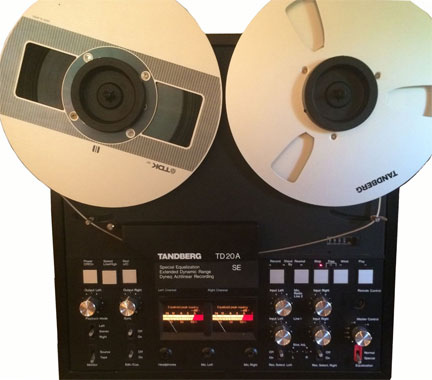 Tandberg tape recorders dominated the Norwegian market, and had a reputation for advanced technology and high quality at reasonable prices.
Tandberg tape recorders dominated the Norwegian market, and had a reputation for advanced technology and high quality at reasonable prices. 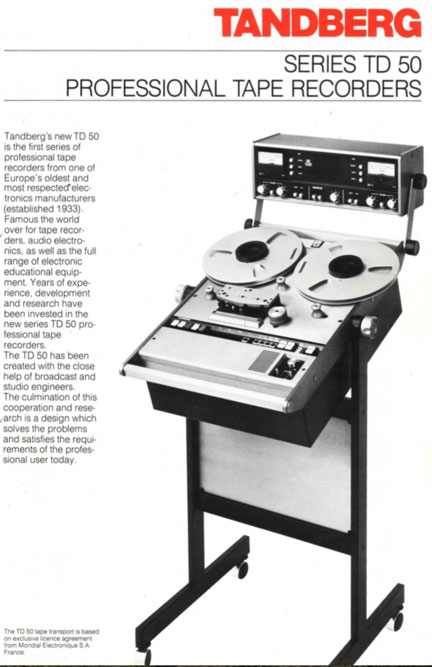
It was on Tandberg reel-to-reel machines that President John F. Kennedy recorded many meetings in the Cabinet Room of the White House, including those associated with the Cuban Missile Crisis.
The Kjelsas factory also started producing TV sets in 1960, and in 1966 a second TV plant was opened in Kjeller in Skedsmo. Color TV's were added to their lineup in 1969.
In 1972, Tandberg purchased Radionette, another large Norwegian electronics firm now focussing on televisions.
By 1976, TV's were Tandberg's major product and their factories employed 3,500.
However, that same year a major economic downturn seriously disrupted the company, and by 1978 it was insolvent. A shareholder revolt removed Vebjorn Tandberg from control of the company, and he committed suicide in August.
In December the company declared bankruptcy. In the aftermath of the bankruptcy, the original Tandberg was split into three parts.
The television manufacturing portions became Tandberg Television, Tandberg Data took over the tape recording side of the company and moved it purely into the computer storage field, and the remaining portions lost the "Radiofabrikk" to become, simply, Tandberg.
In 1984, the consumer audio equipment division was spun off to become Tandberg Audio.
Here's a Norwegian quote regarding the Tamdberg Series TD 50 (1984) which evidentually never made it to production. Here's a pdf as well.
Tandberg made for several years bandwriters who were used professionally even though they were not designed for it. TB6 (1964?) And later TB6000 (1969) had very good data and were probably used for recordings. 10X and 10XD (1974?) Were the first with 10-inch coils and were used by many advanced amateurs and maybe even for purely professional use. TD20 A (1978) should only be an amateur band player, but was still used professionally even though inaccessible bandwidth and slow start were criticized. The TD20 A - SE came in 1981 with improved signal noise conditions on special tires, but with the same drive. At about the same time, cassette players and amplifiers came with a new amplification technique. It was therefore a wish to have a professional drive that could be combined with new circuits. It is expensive to develop mechanics, so we looked for a cooperation. Schlumberger had a big and nice machine, but at first there was little interest. Later we learned that they were very interested in cooperation. We chose the small French company Mondial Electronique. They collaborated with an engineer in Radio France who had the basic idea of a good drive. We showed a prototype and made brochures to test interest, but the work stopped in 1984, I think when Tandberg Audio had to narrow down. In 1991, we handed some prototype parts to the French engineer in Paris as souvenirs. N
In the 1990's Tandberg still released high end compoments including the TCD 3004 Cassette Recorder - Thanks to Max Willauer for sharing his photos on one he sold.
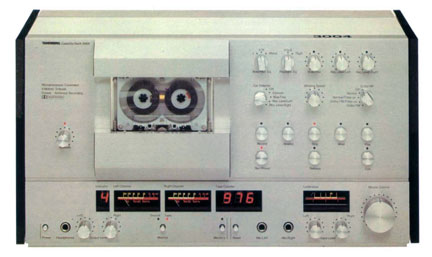
TCD 3004 Cassette Machine The really professional cassette machine
Corresponds to all professional requirements that can be placed on a cassette recorder. E Can be equipped with an integrated mef-electronics, ::!. H. Without additional measuring devices can be optimally measured on all available bands.
E Microprocessor-controlled, newly developed professional double-capstan 4-motor drive system. E Highly developed electronics with dynamic recording equalization DYNEQ, optimized recording system ACTILINEAR and phase correction sound e Infrared remote control connected 3 variable rewinding speed e Cueing with automatic speed reduction e Digital multiple display
Technical data
Frequency range (to DIN) 14-22000 Hz Frequency range (± 3 dB) 19-21000 Hz Noise level (A curve) 70 dB total harmonic 0 db <3% Flutter 0.09
(Metal tape): 80 dB
Thanks to Max Willauer for sharing the following photos of his Tandberg TCD 3004 cassette reel tape recorder
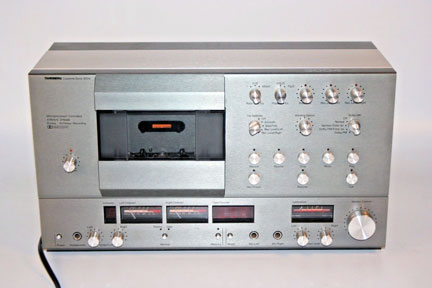
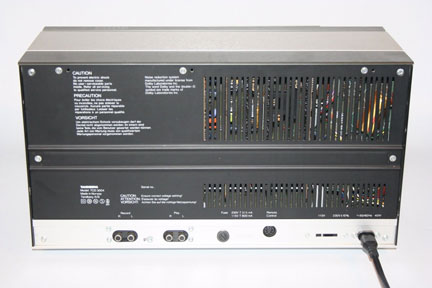
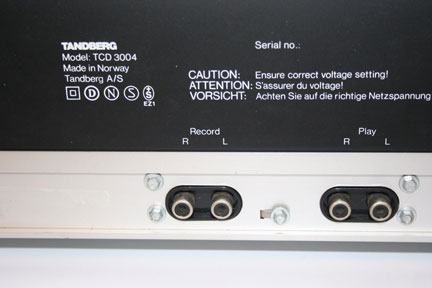
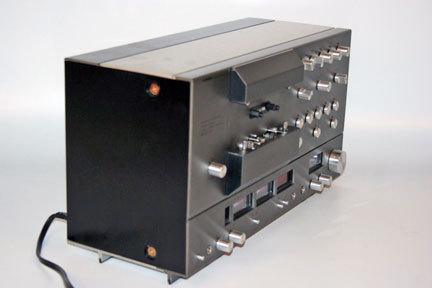
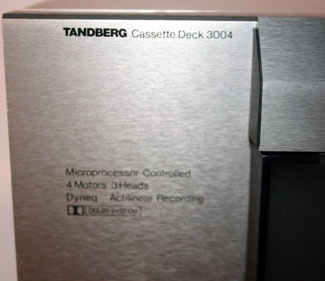
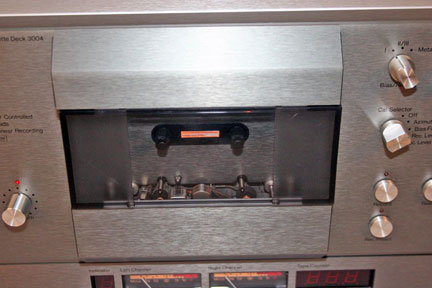
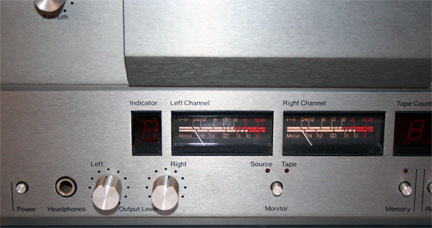
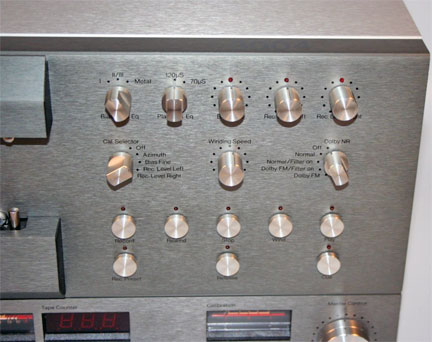
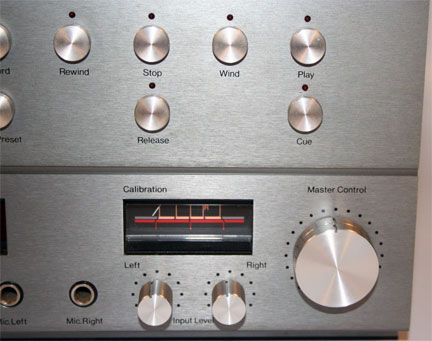
In 1997, The television manufacturing portions became Tandberg Television.
In 1999 the company acquired the Norwegian technology company Internet Technology AS which had developers experienced with the ITU H.323 standard, especially from VoIP-projects like the world's first commercial H.323 VoIP service launched in 1997 with Telenor.
Cisco Systems acquired Tandberg on 19 April 2010.
Tandberg Factory
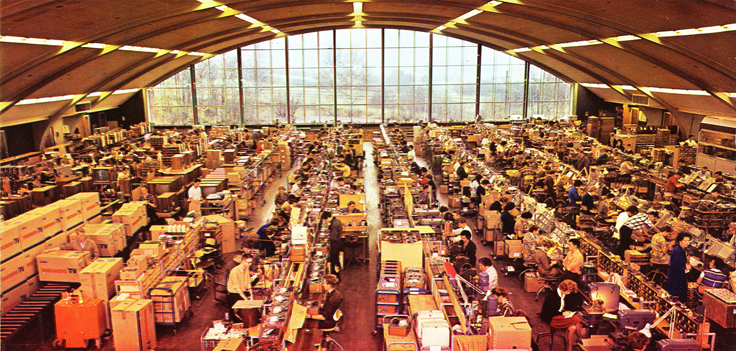
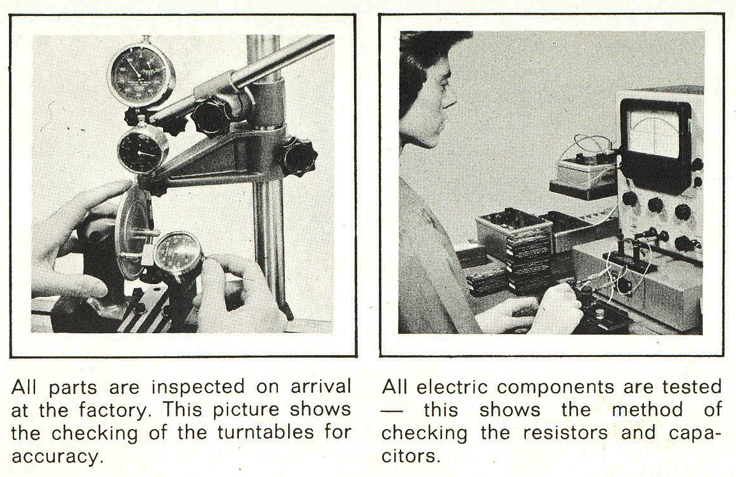
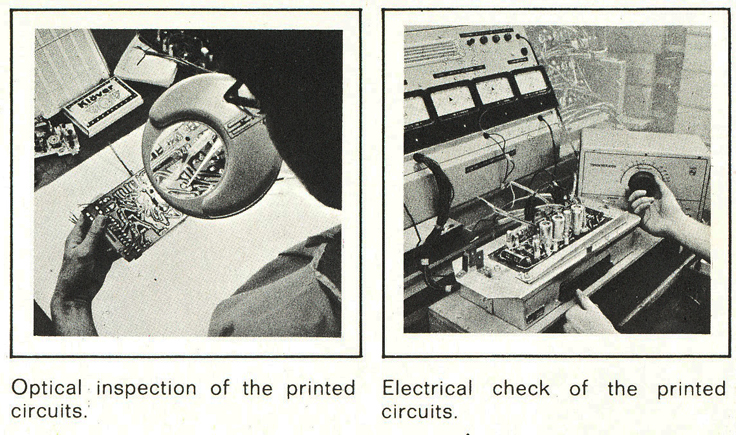
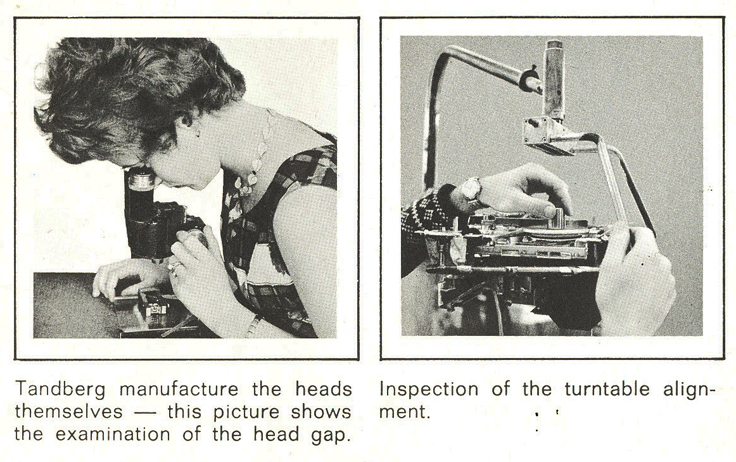
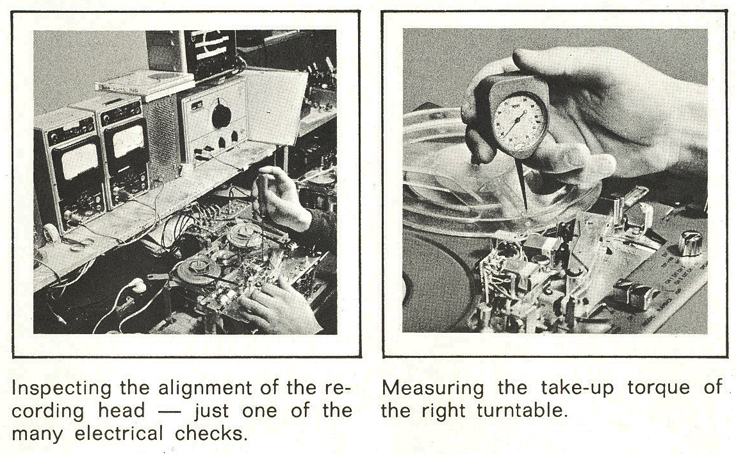
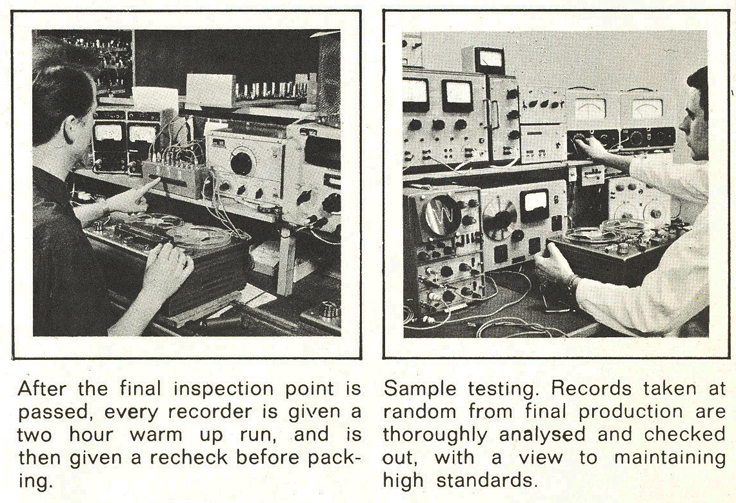
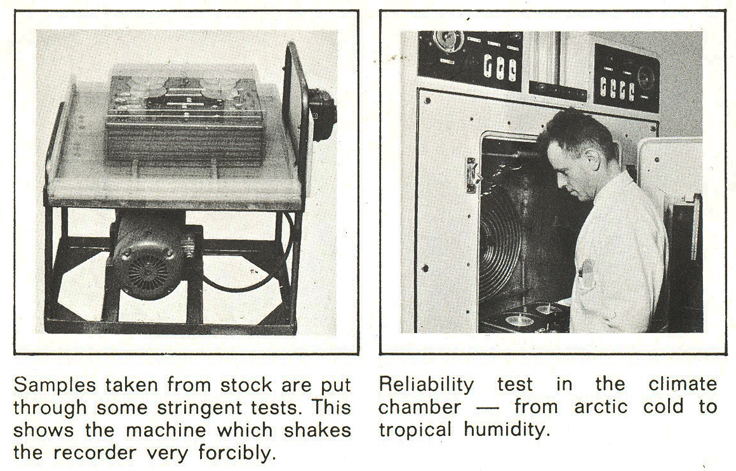
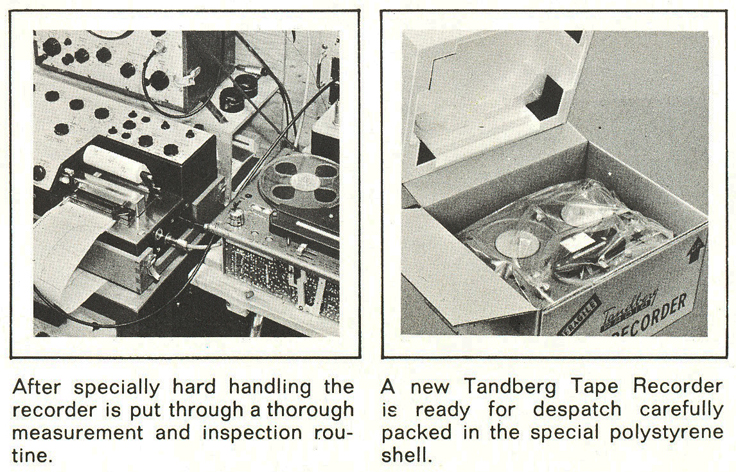
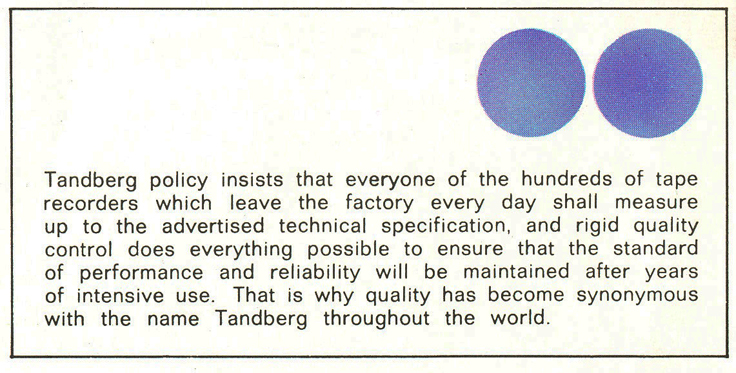
Tandberg Ads
1956
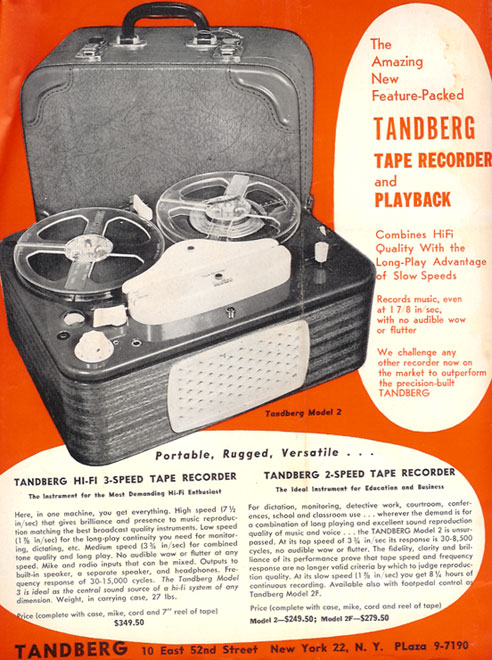
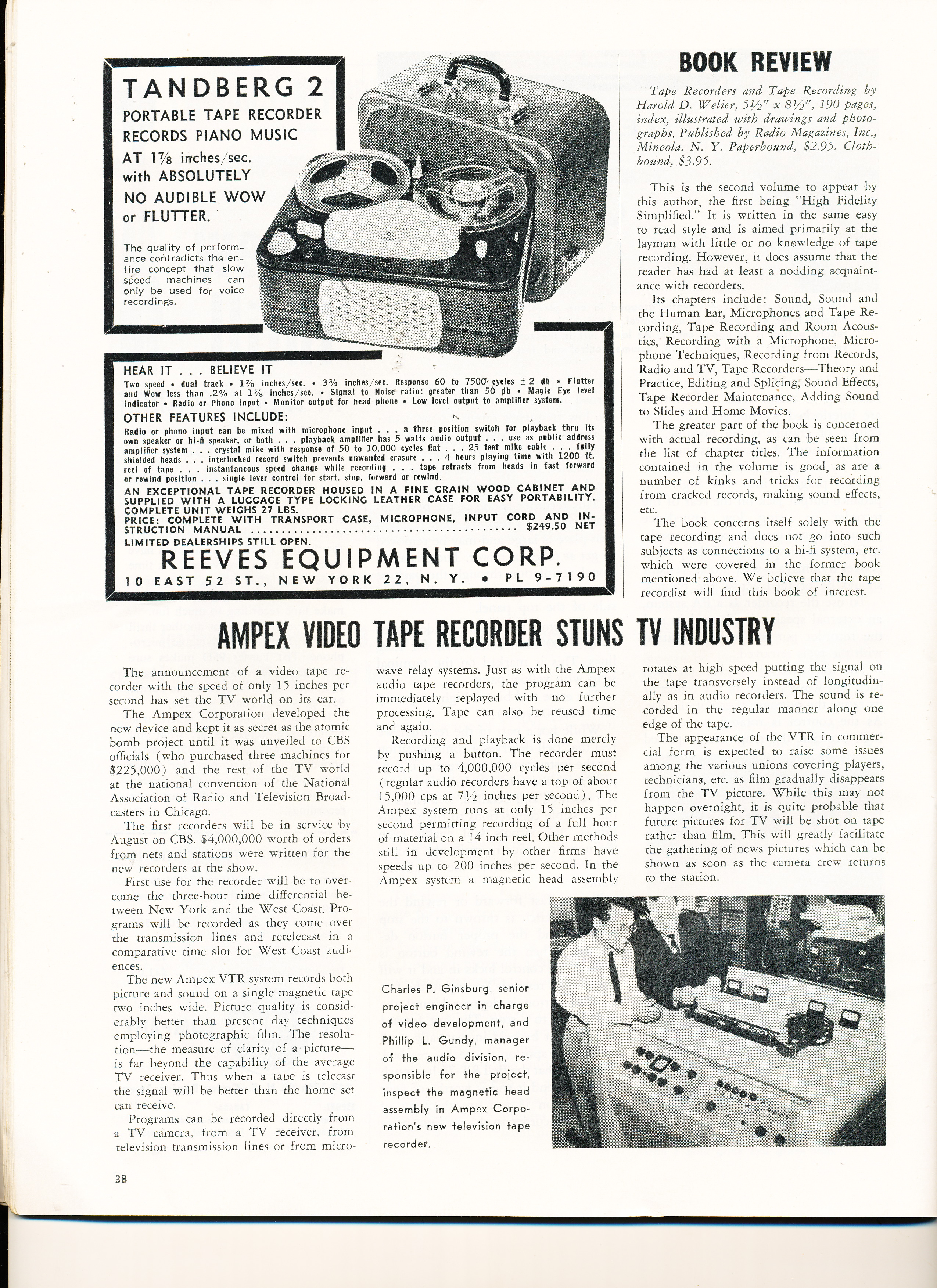
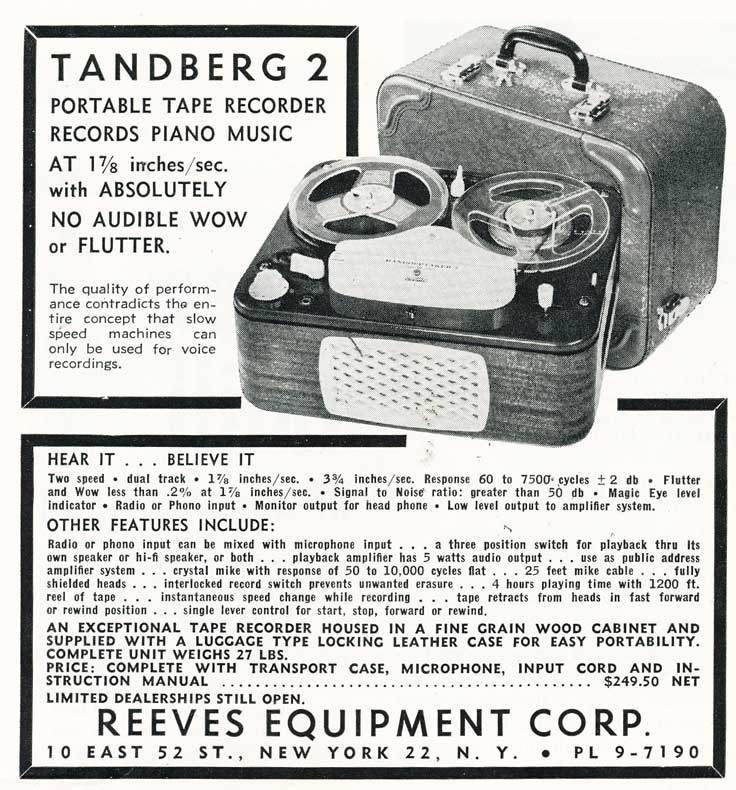
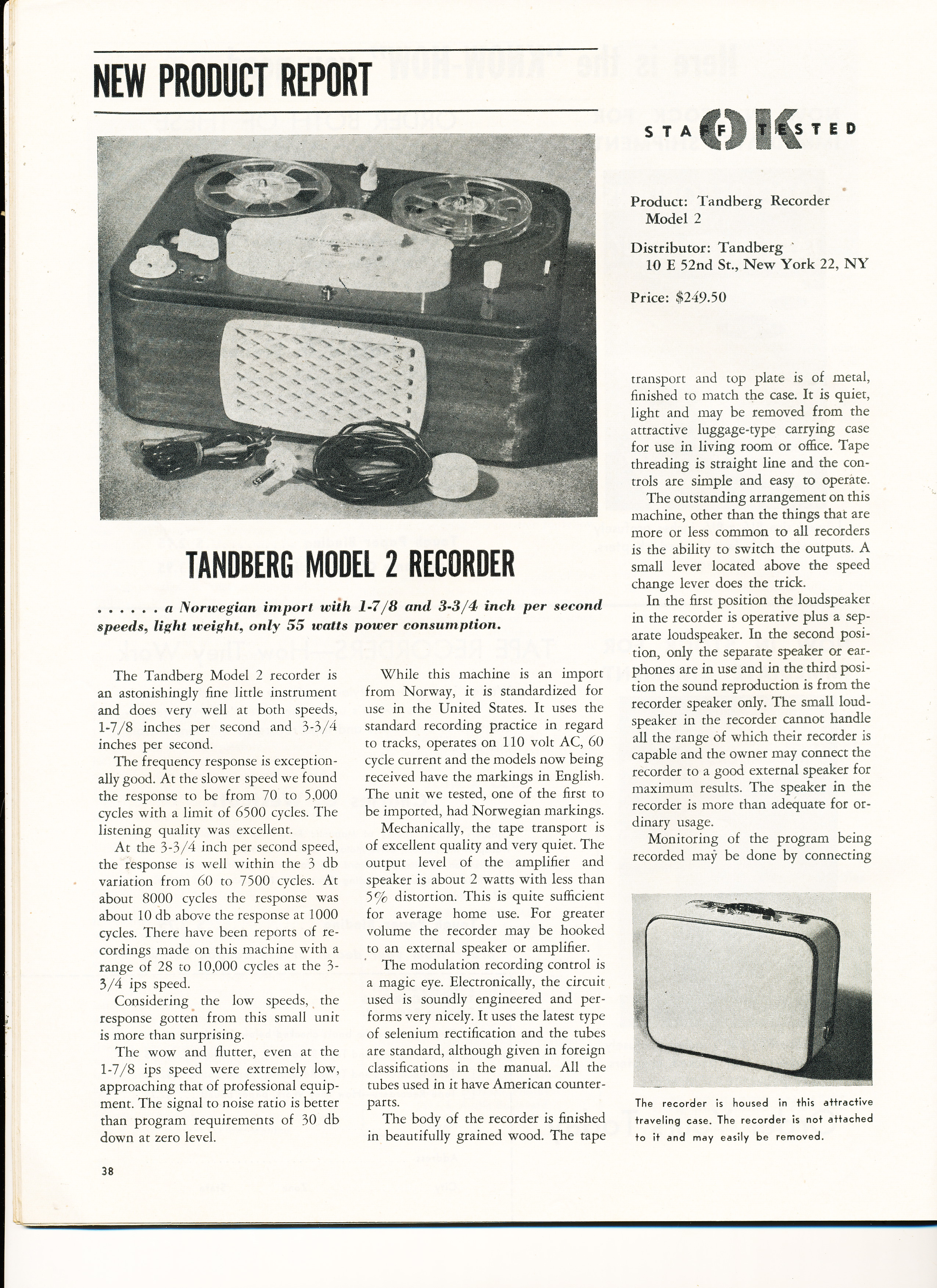
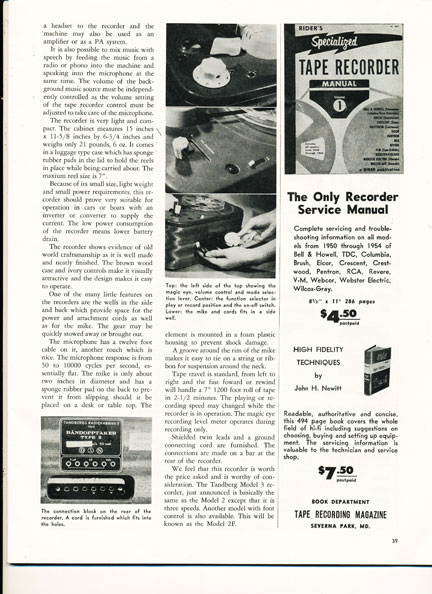
1957
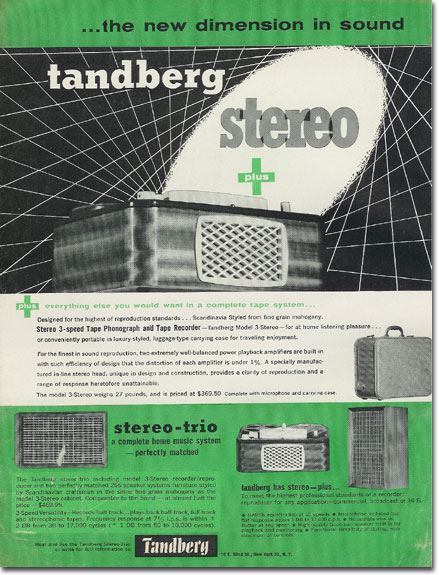
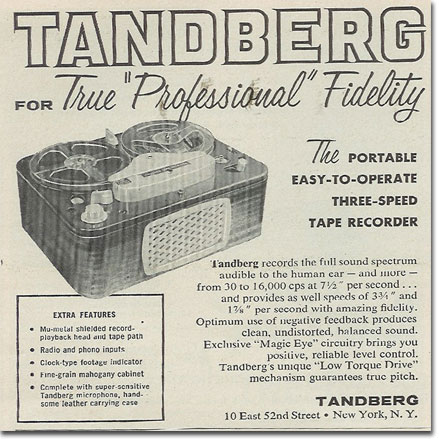

1958
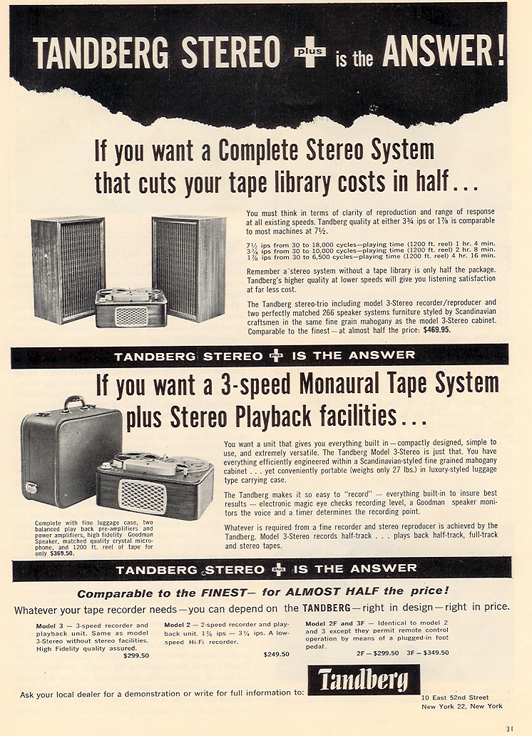
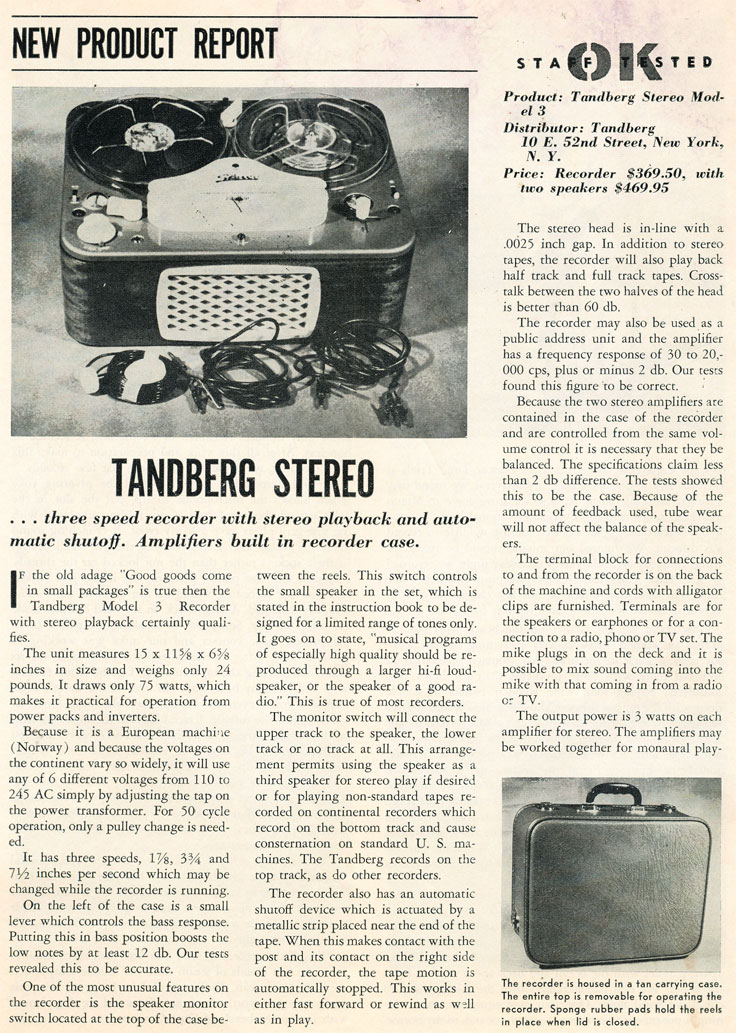
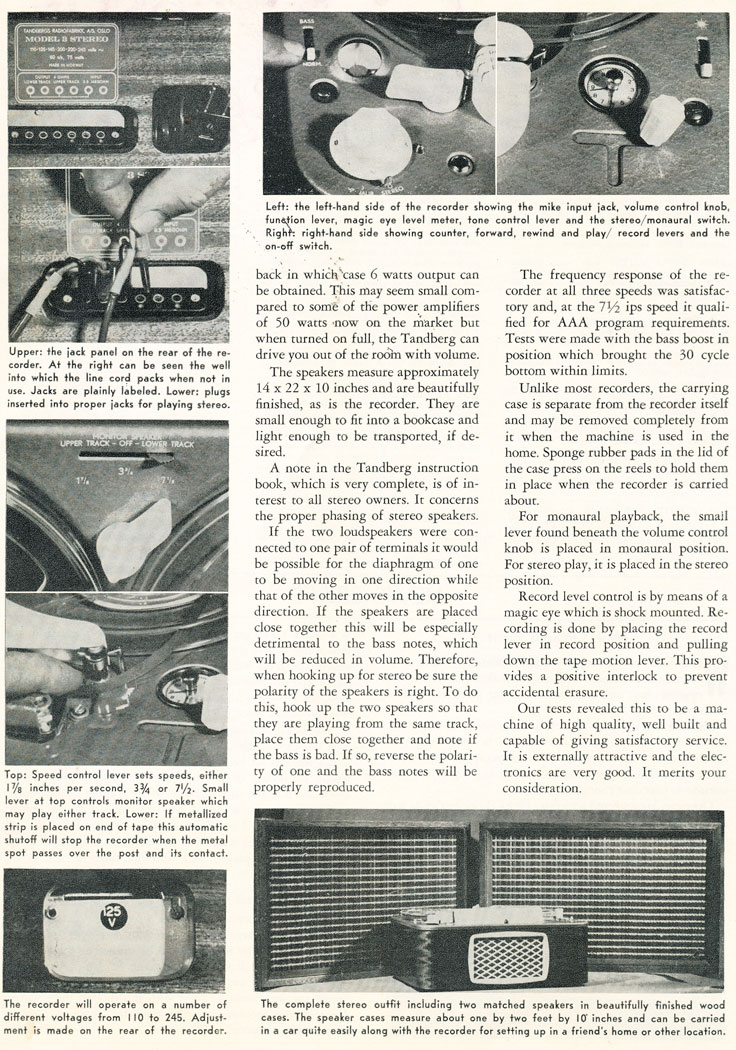

1959

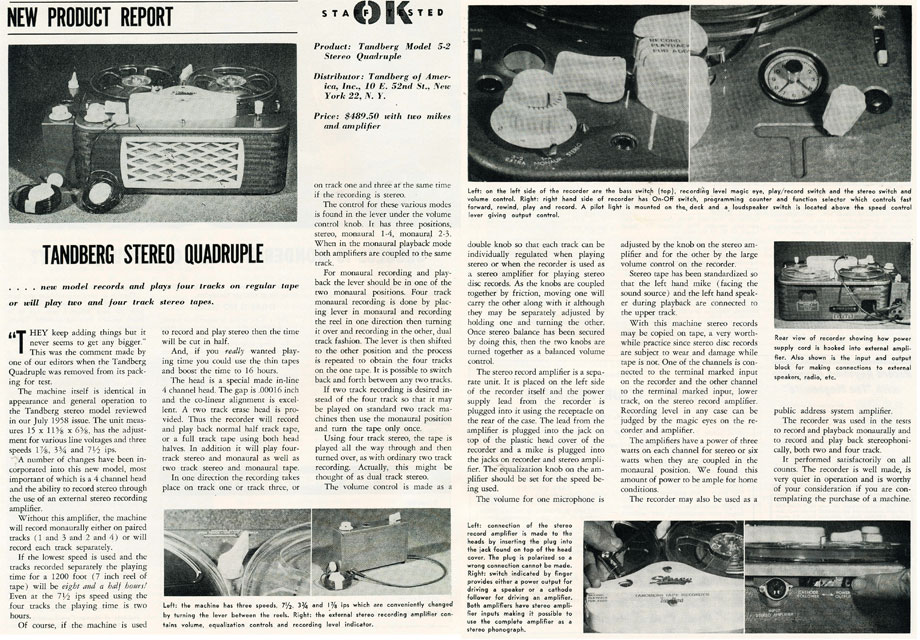
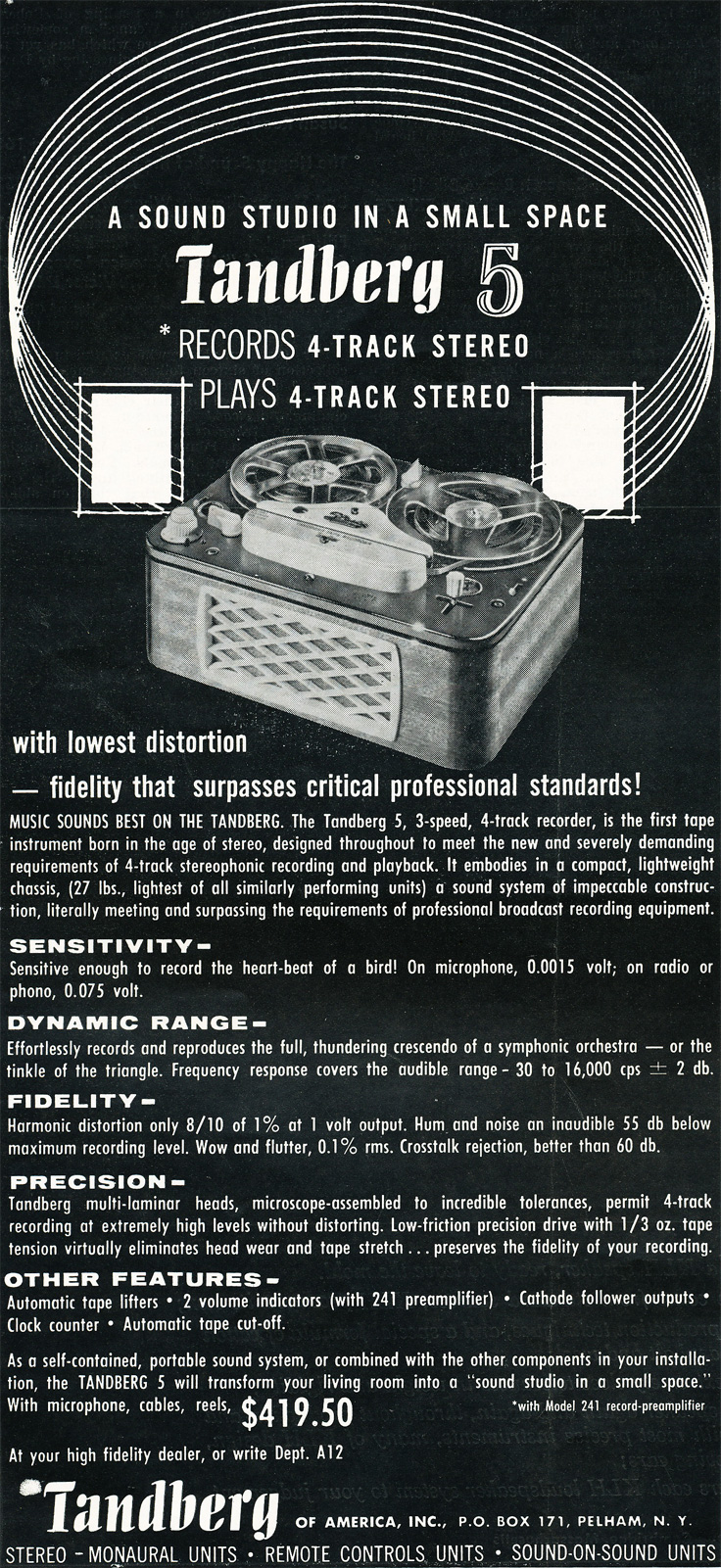
1960

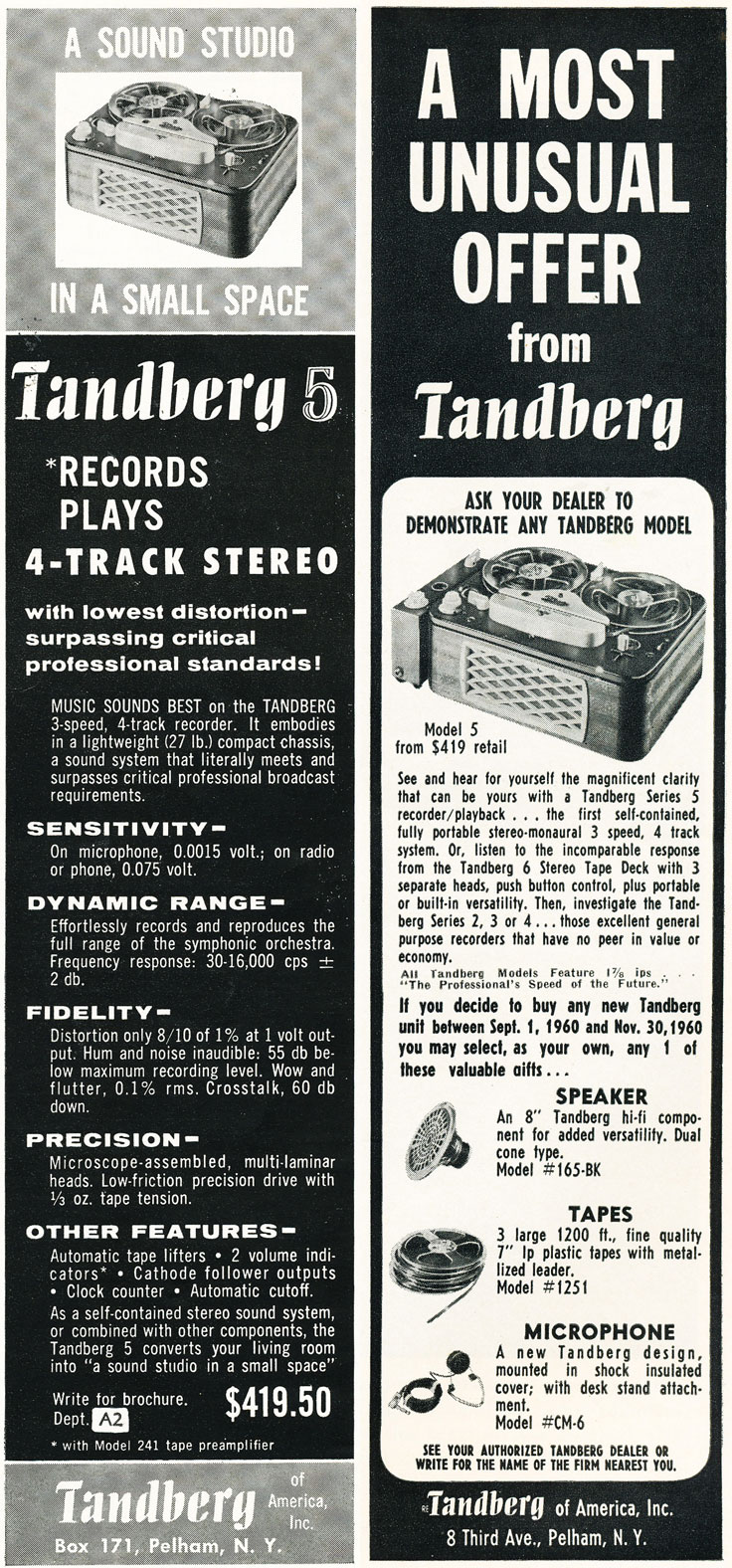
1961


1962
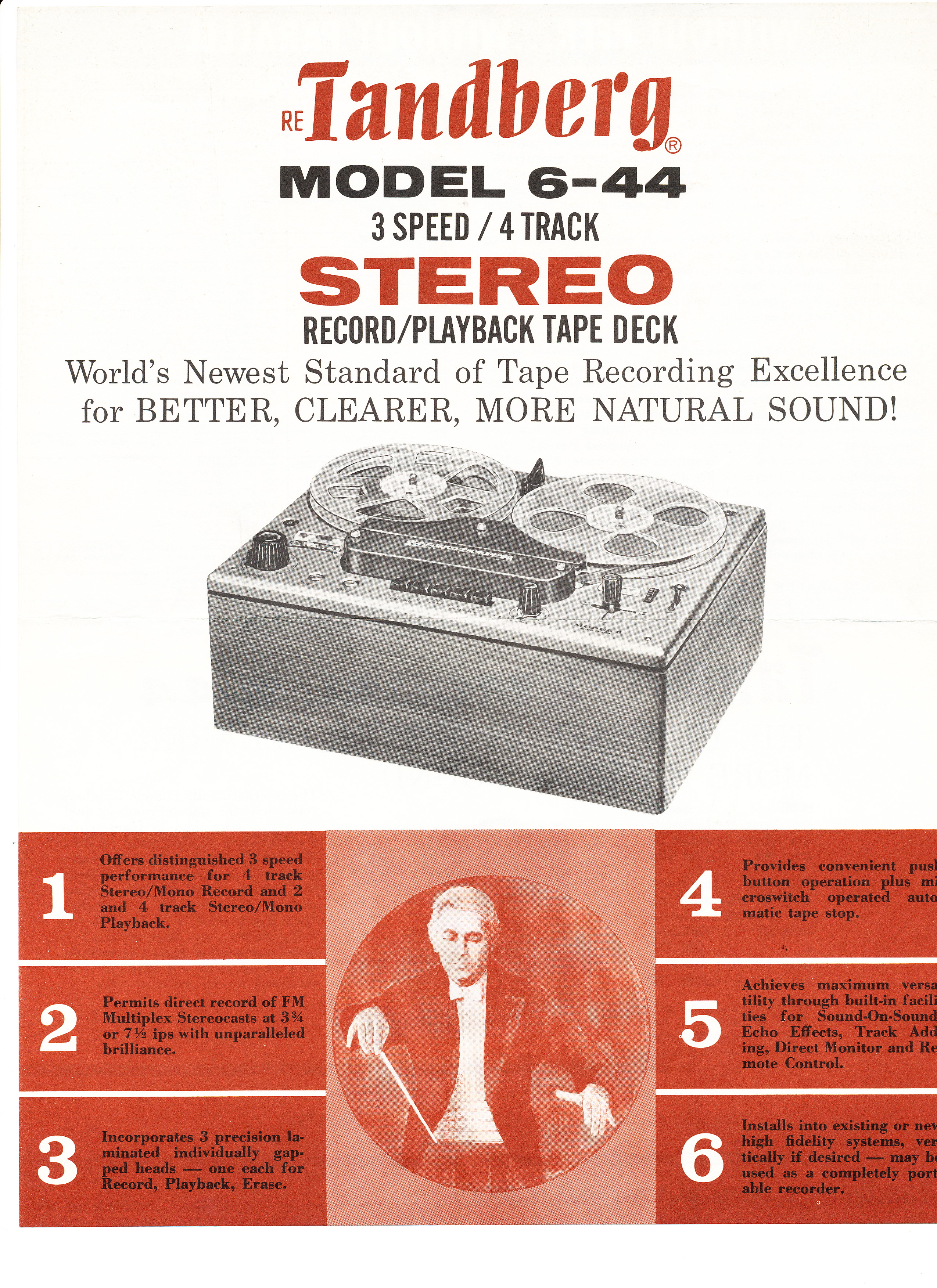
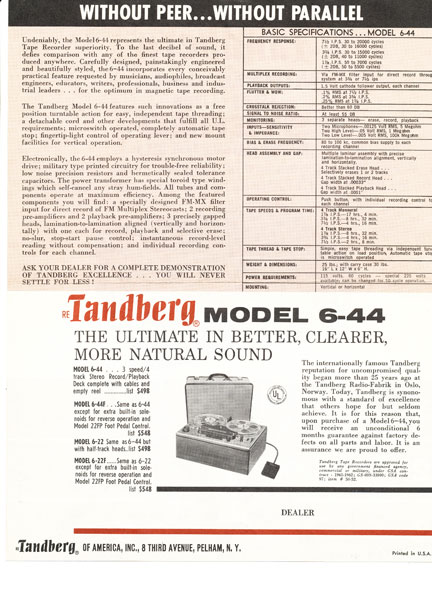
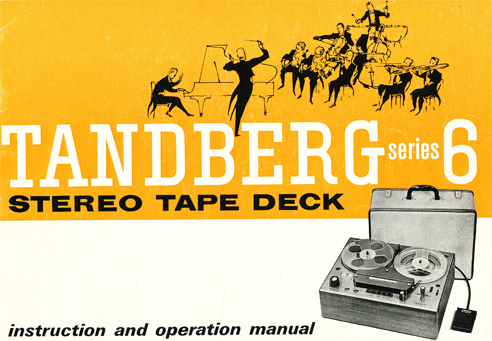
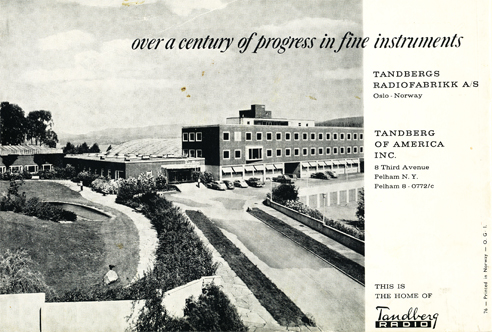
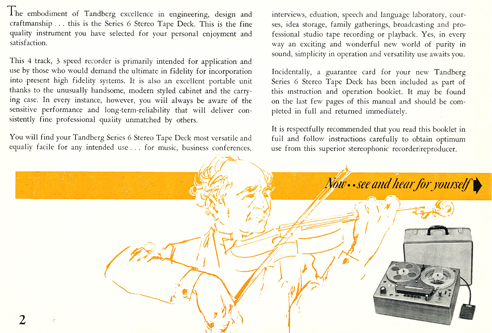
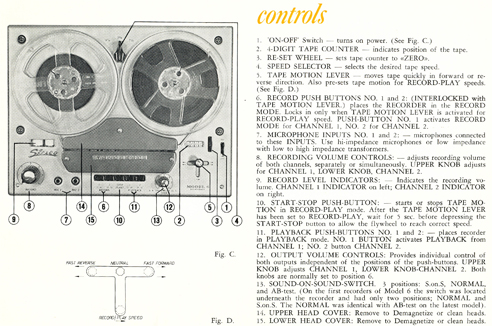
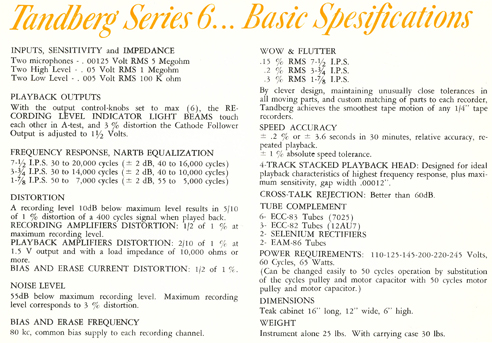
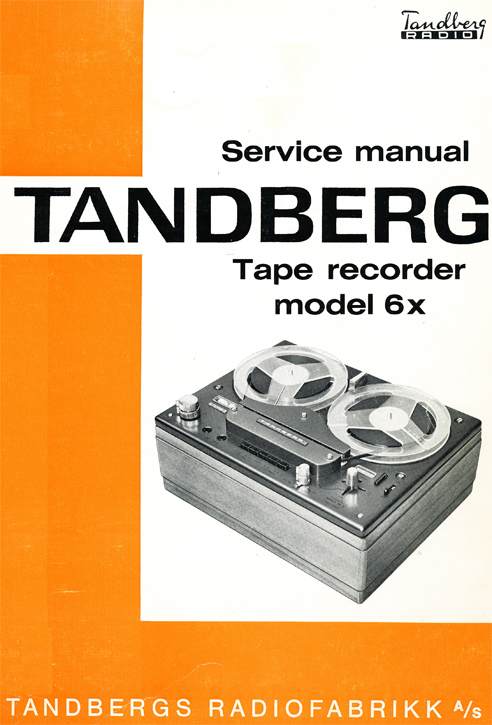
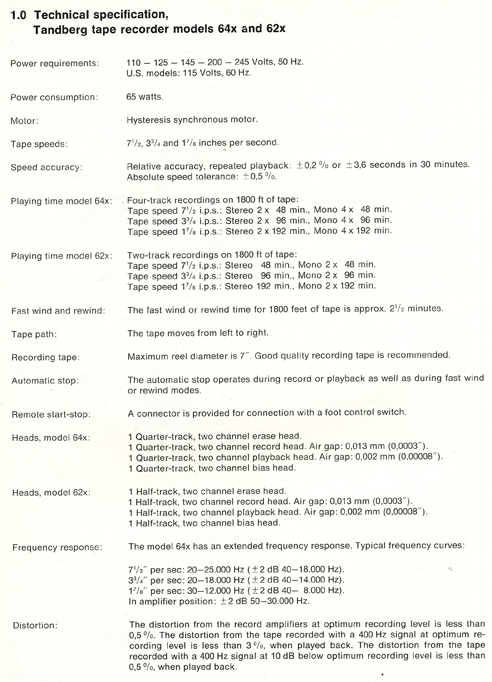
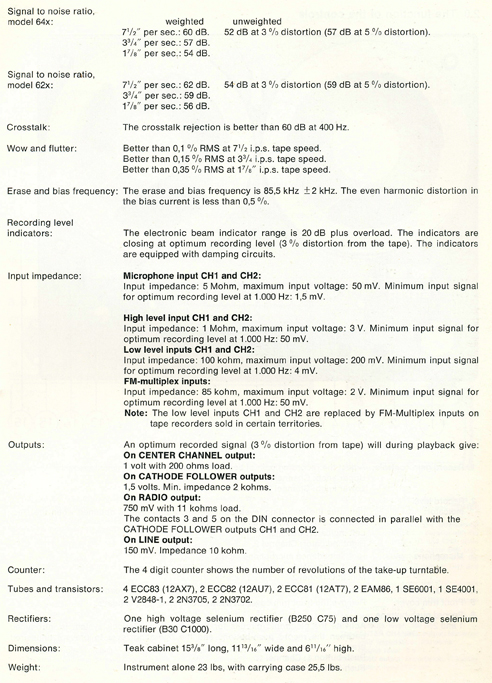
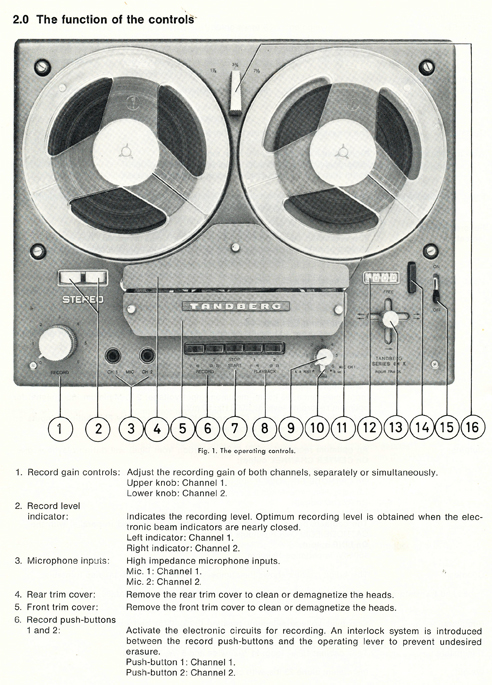
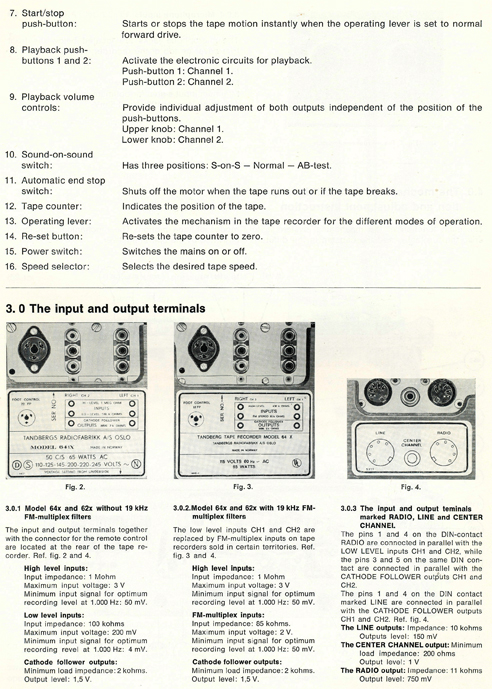
1963
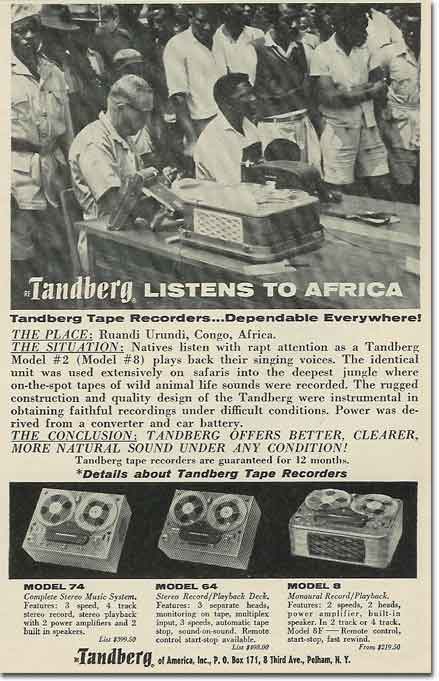
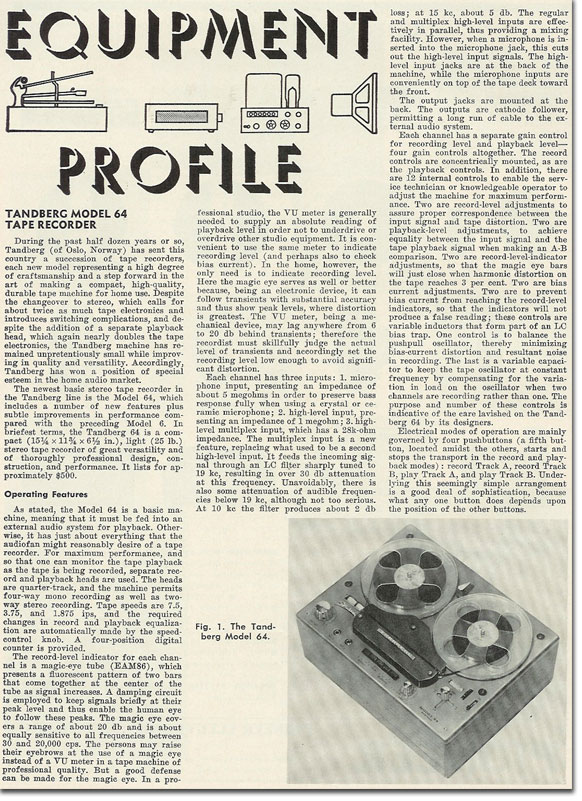
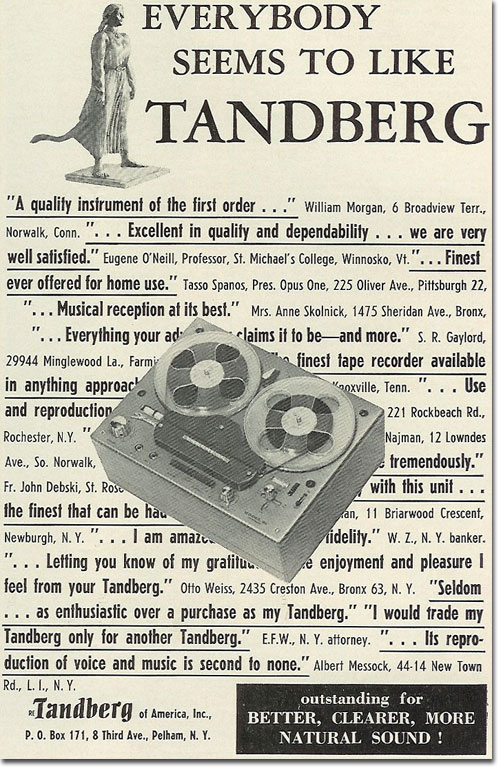
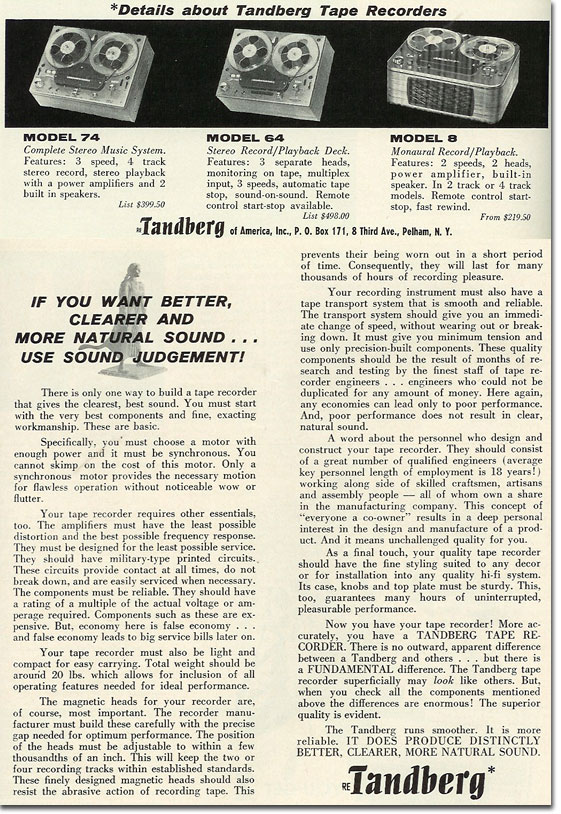
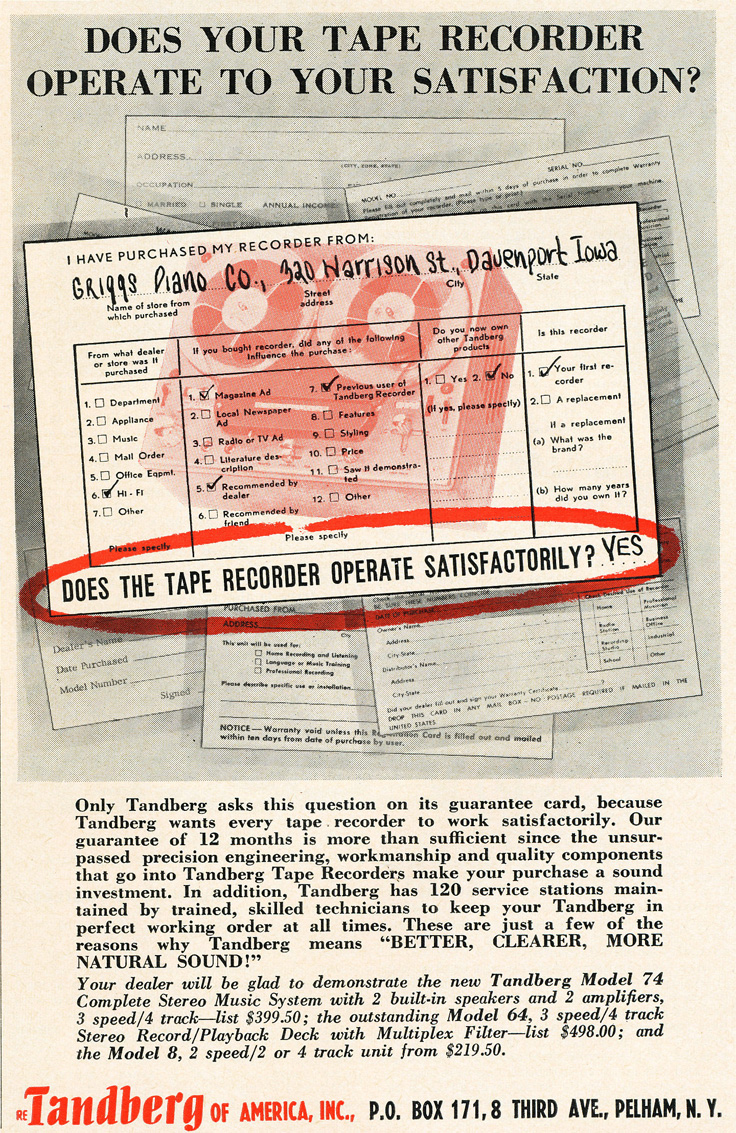
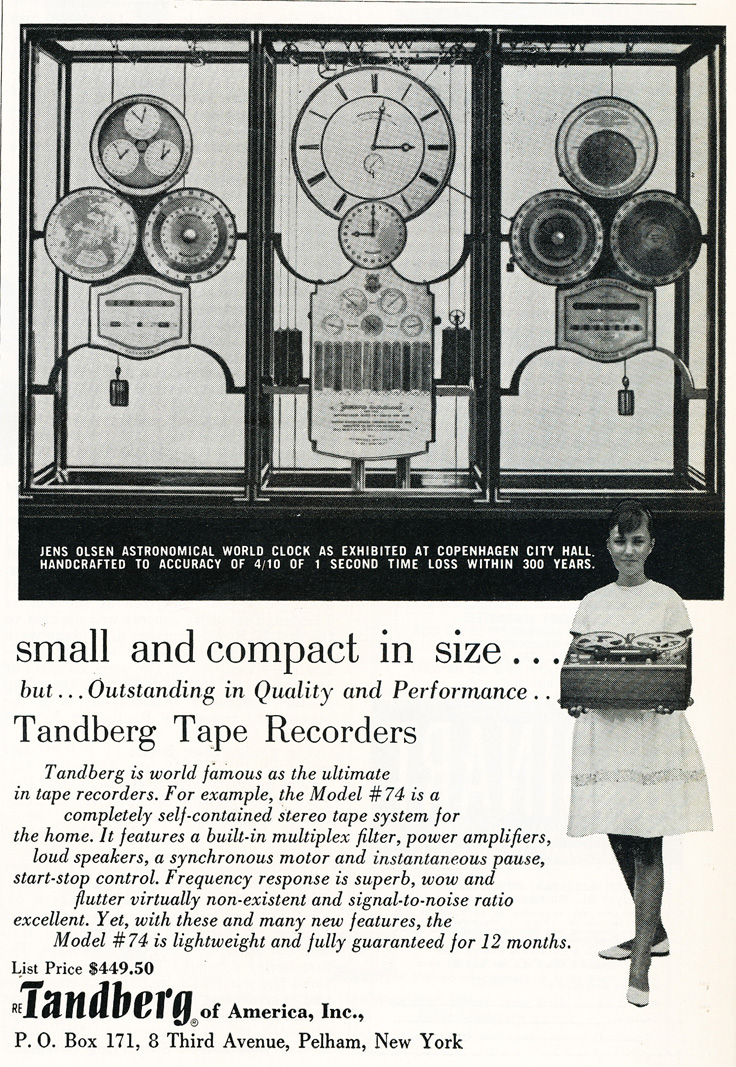
1964
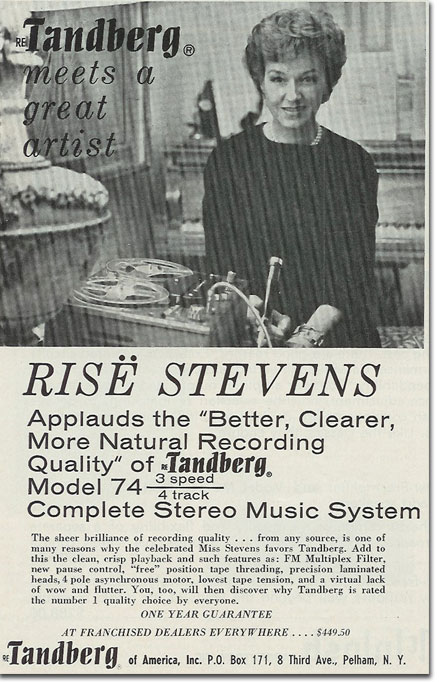
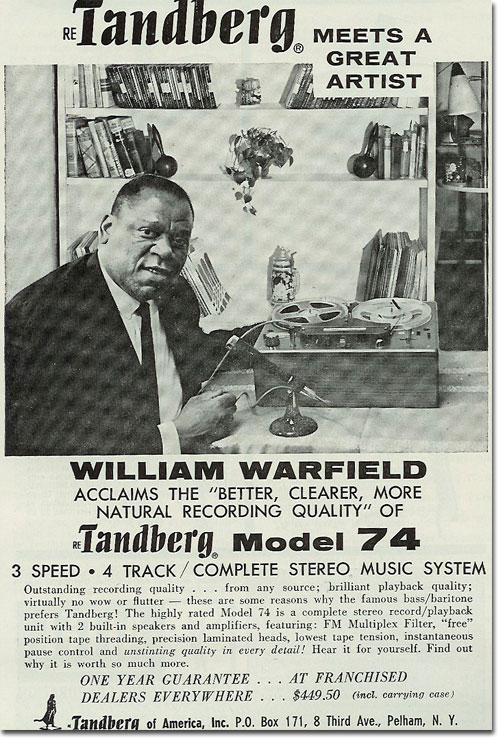
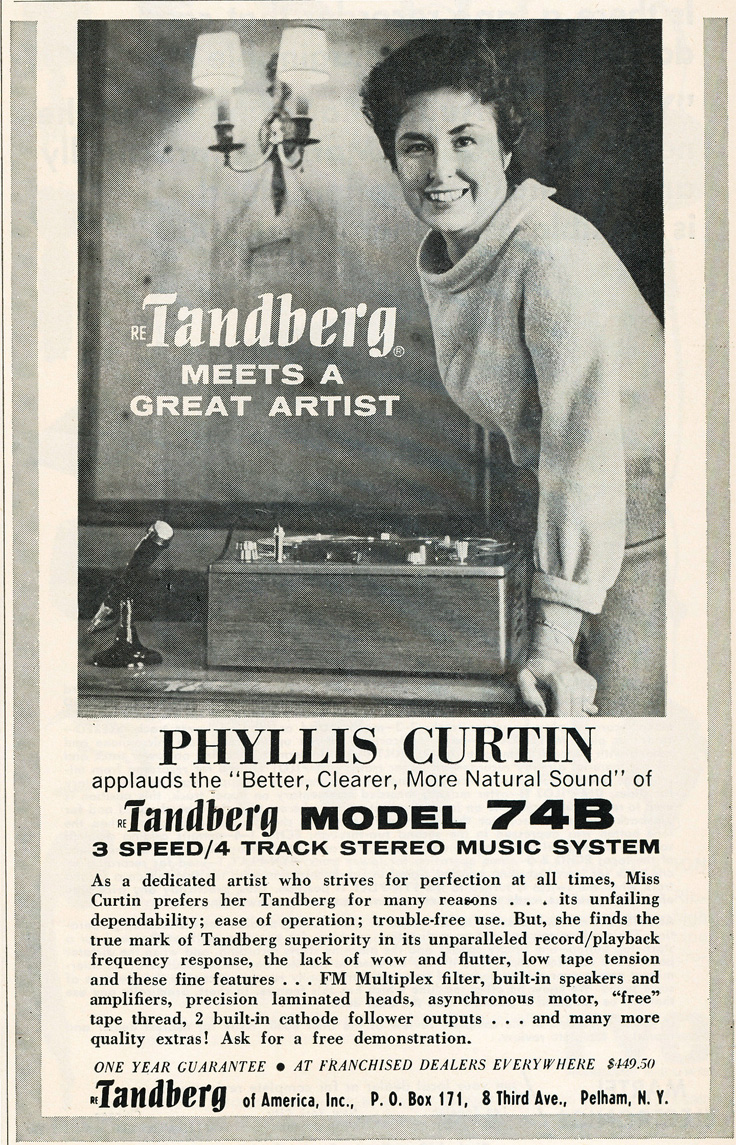
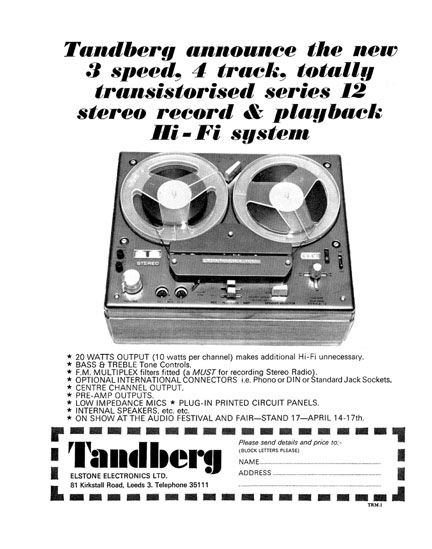
1965
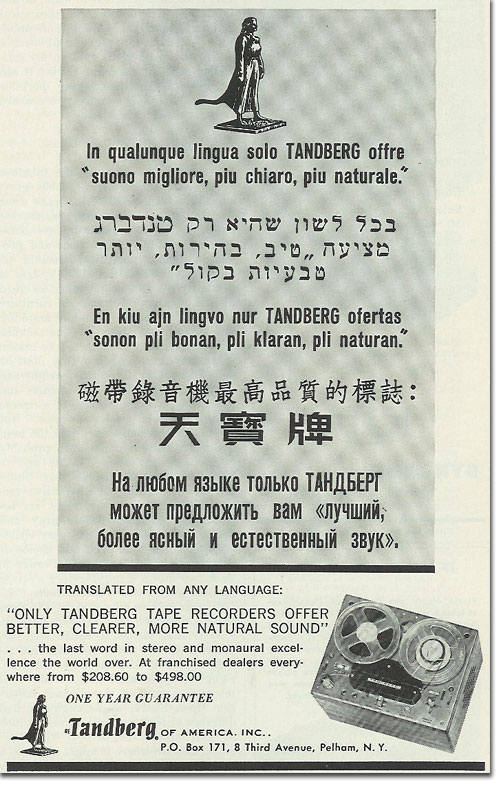
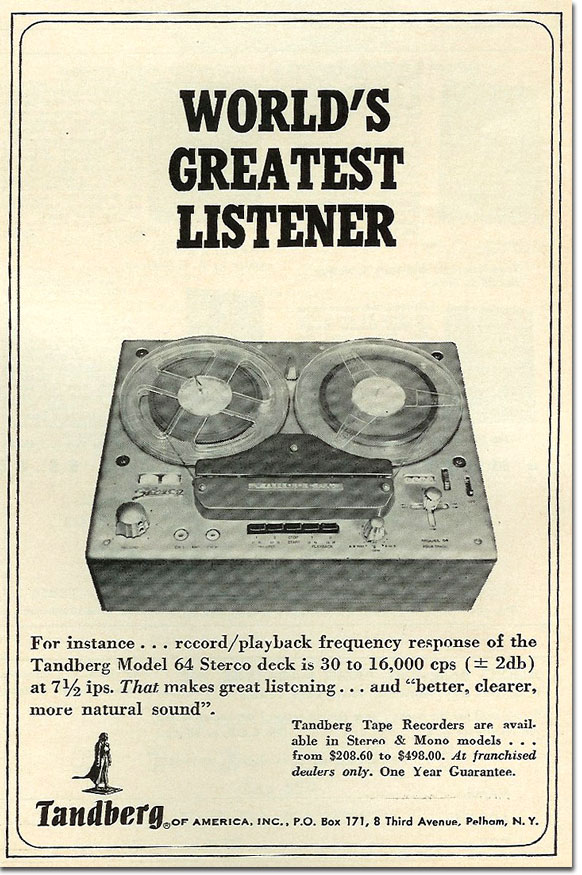
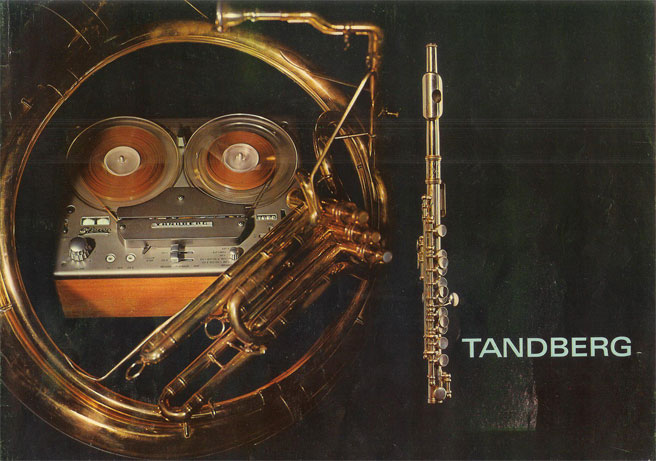
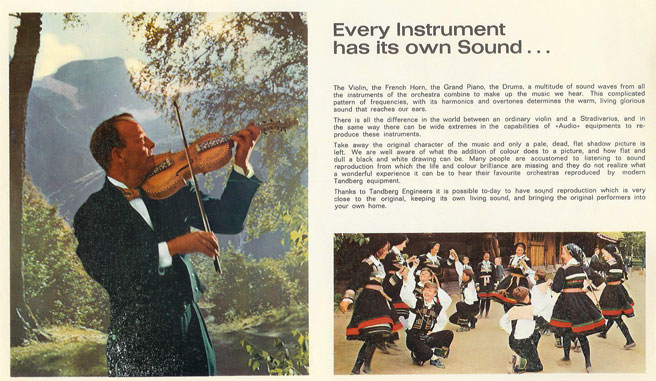
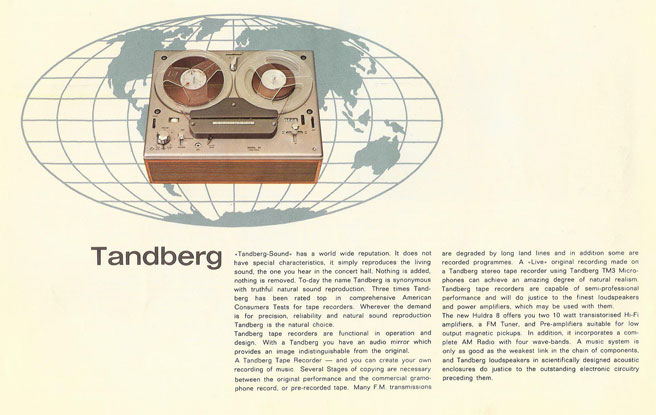
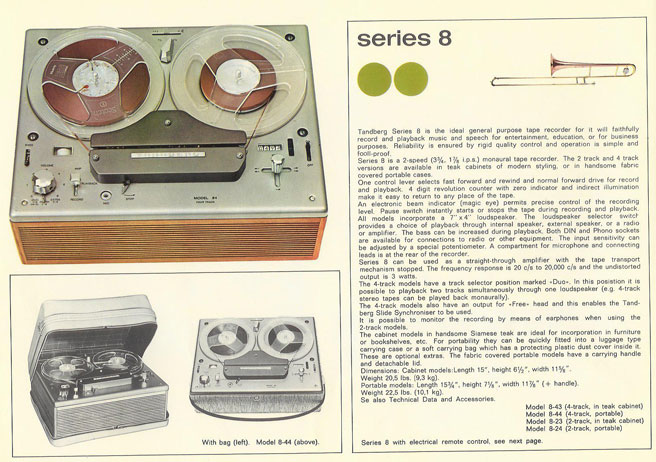
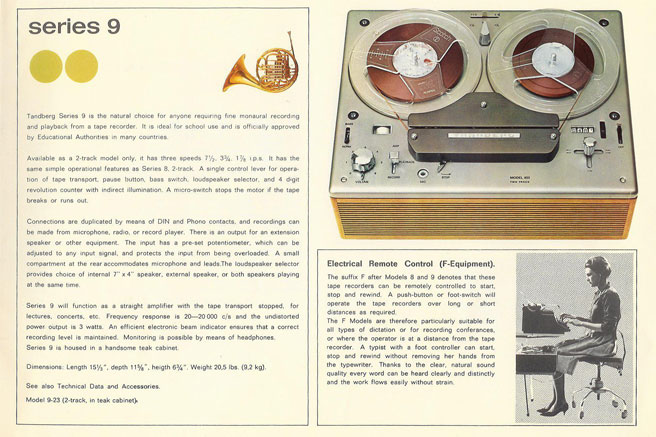
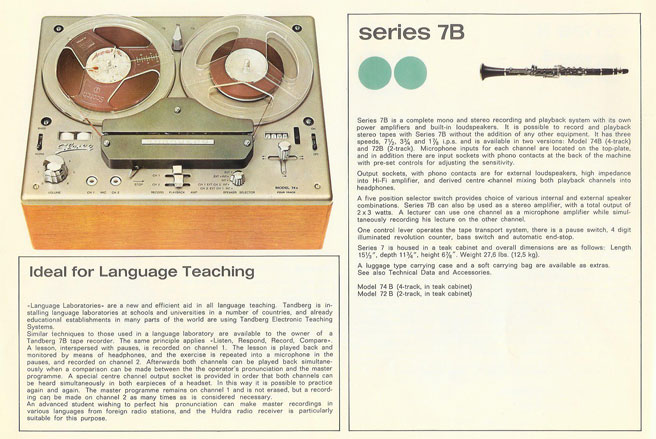
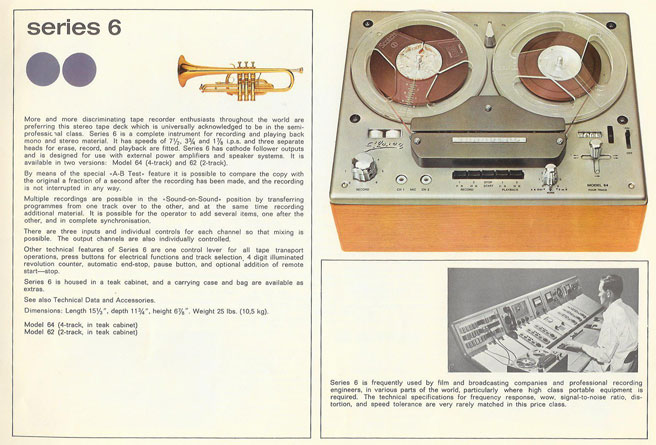
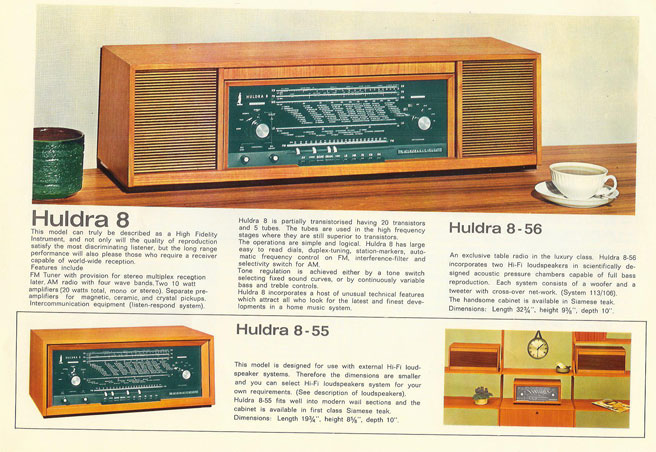
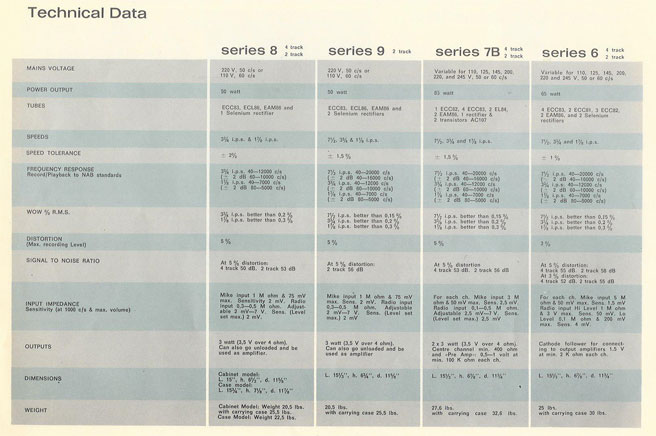

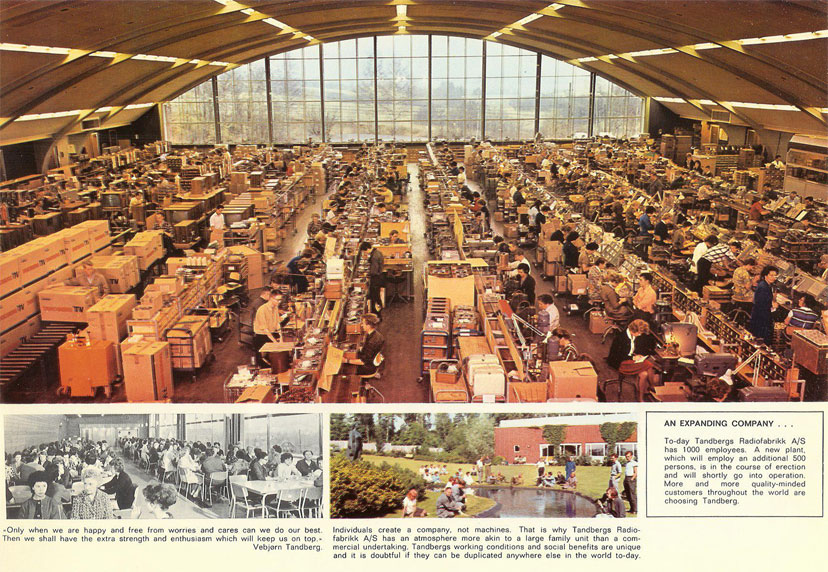
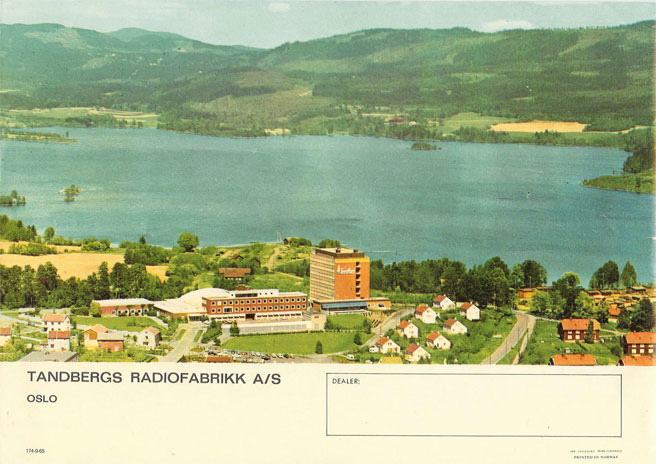
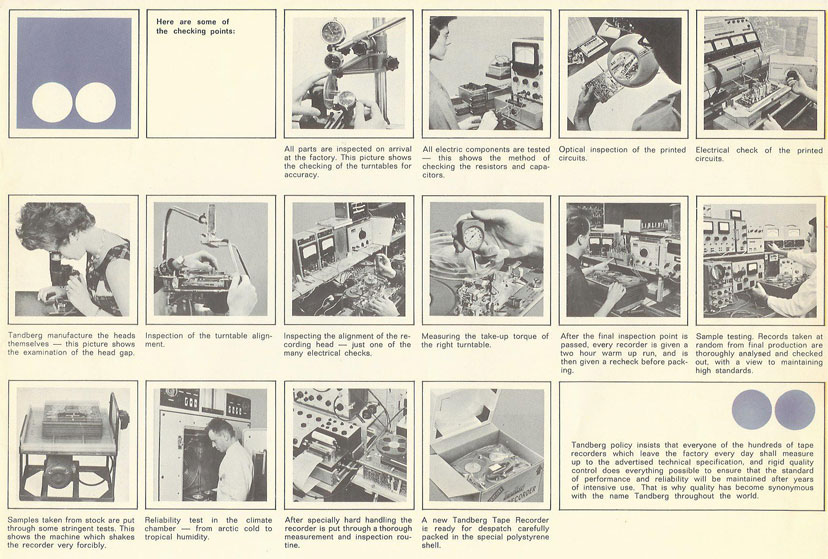

1966
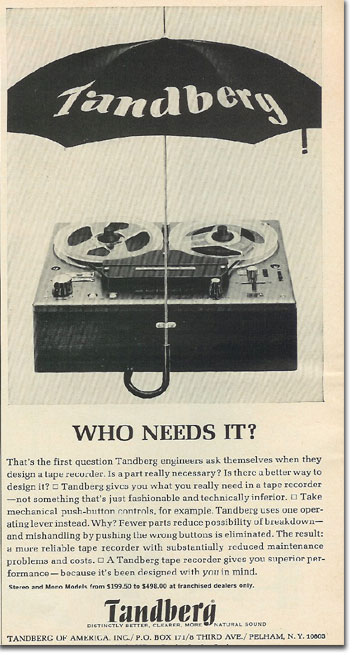
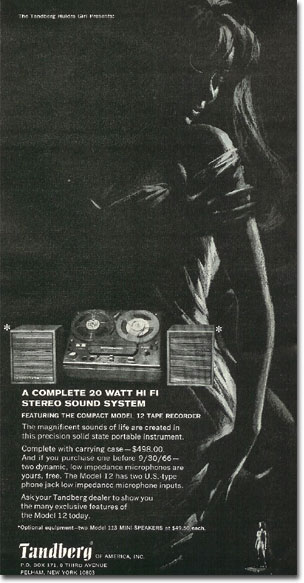
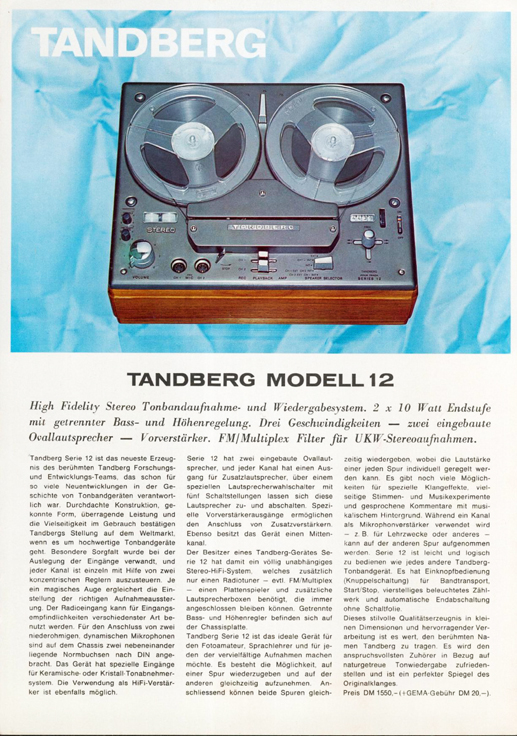
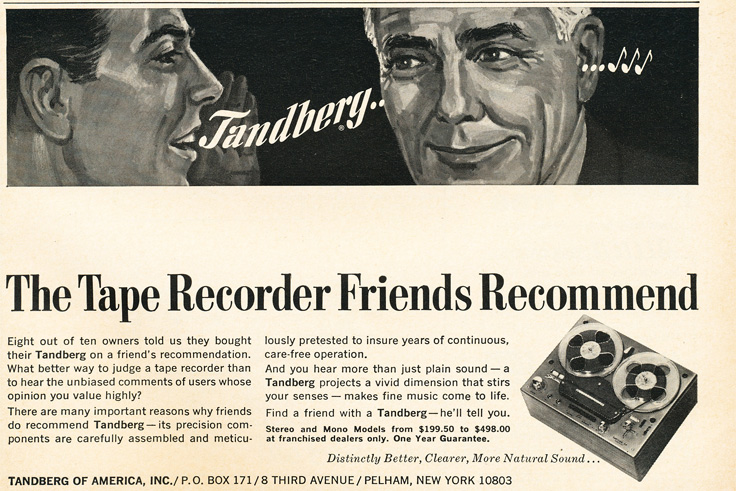
1967
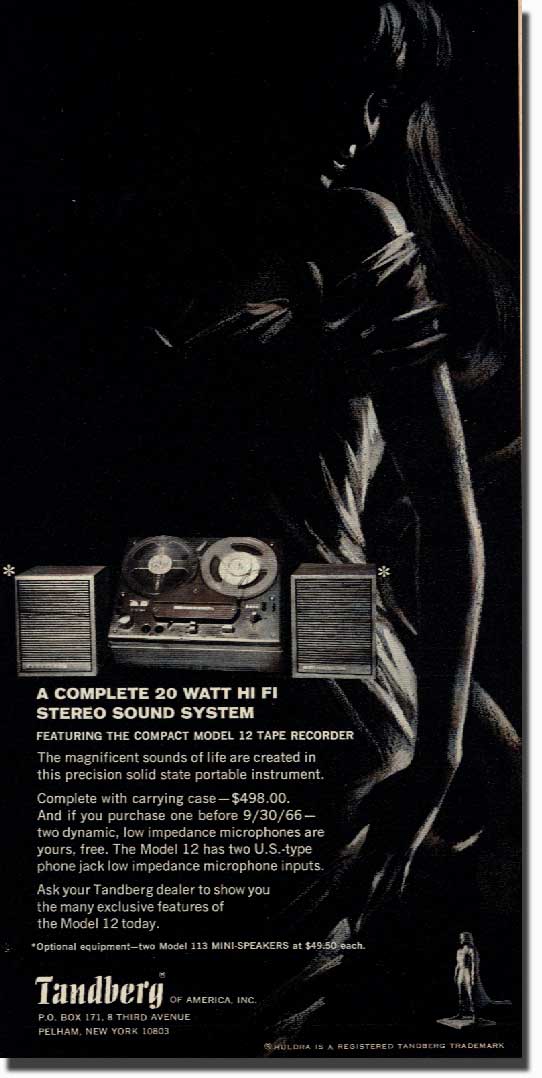
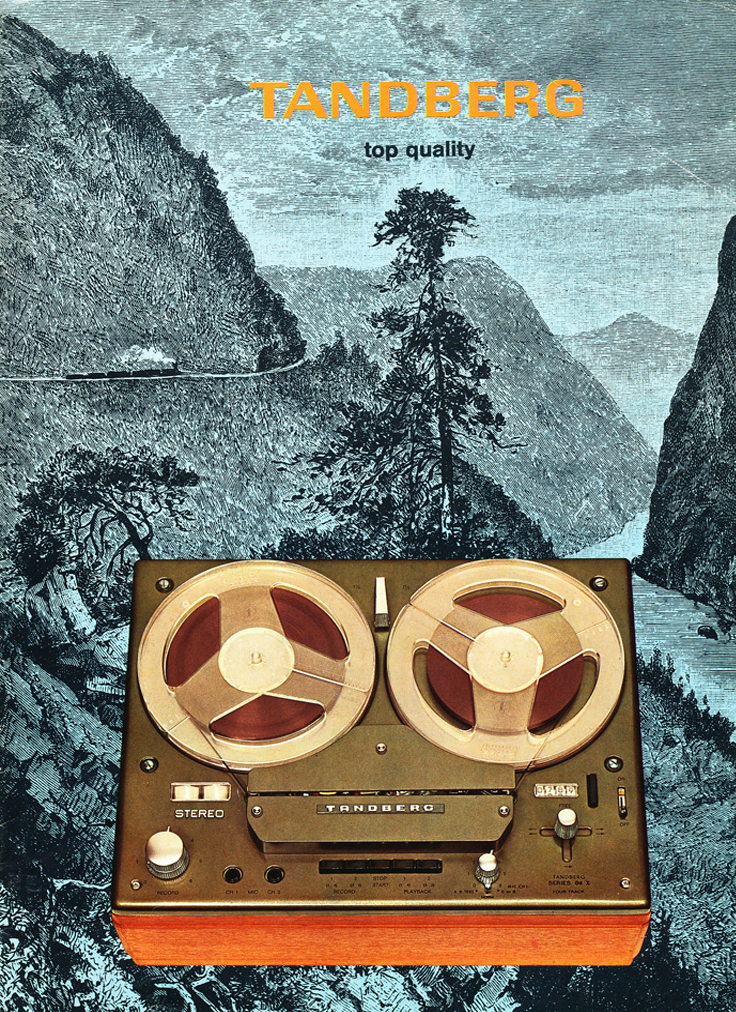
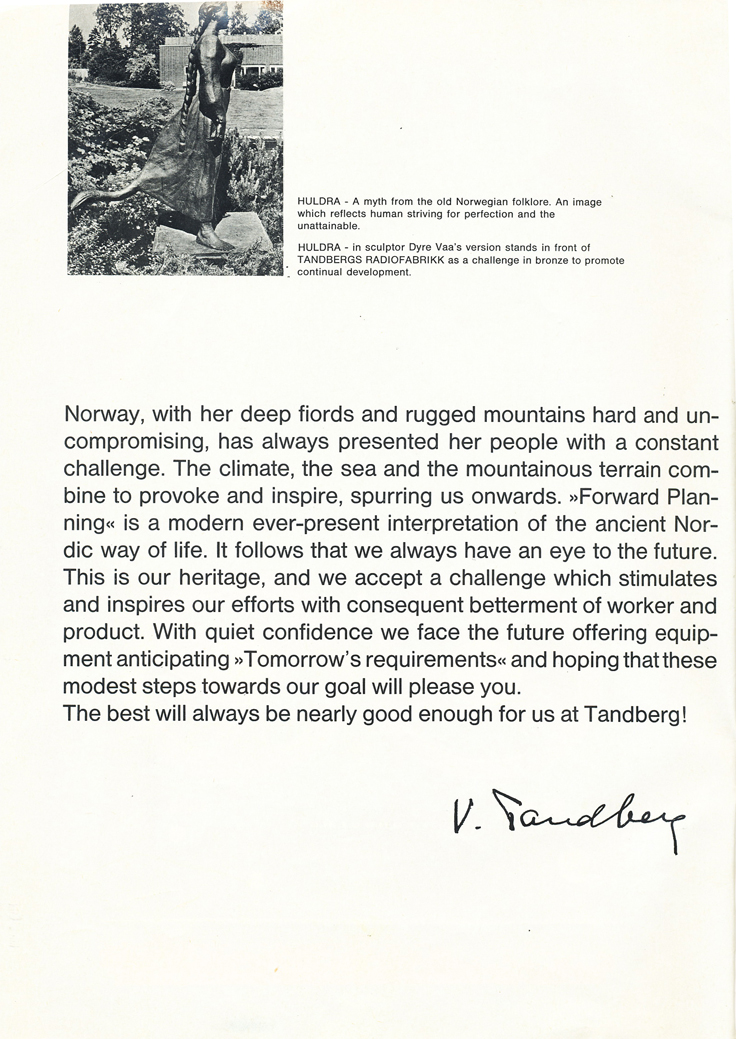
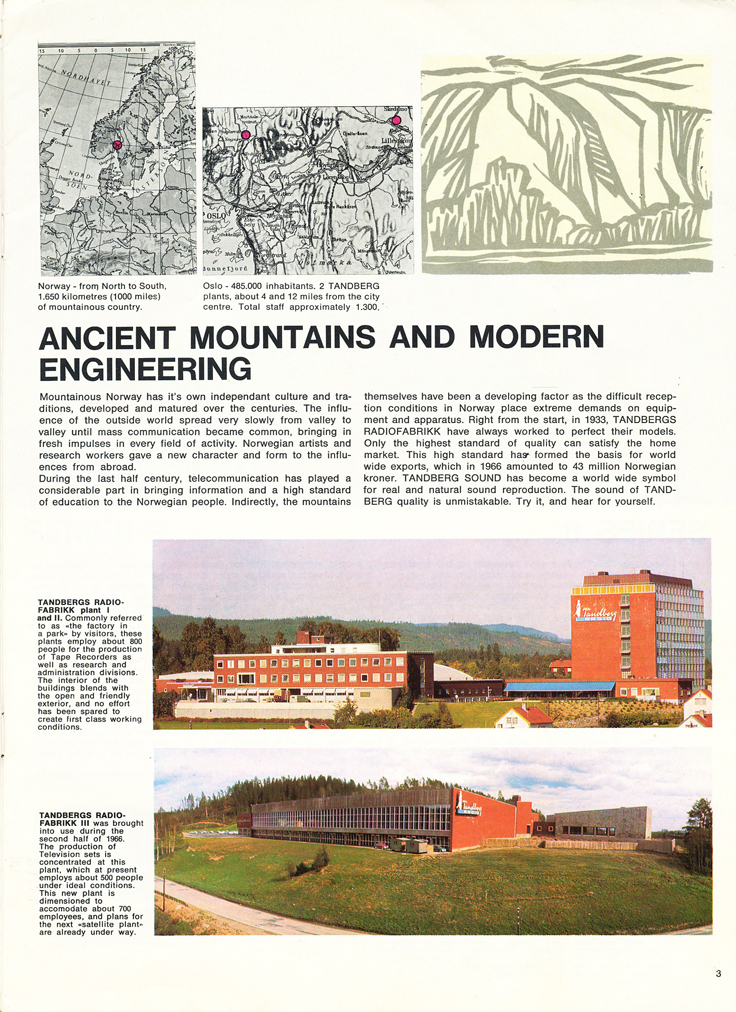
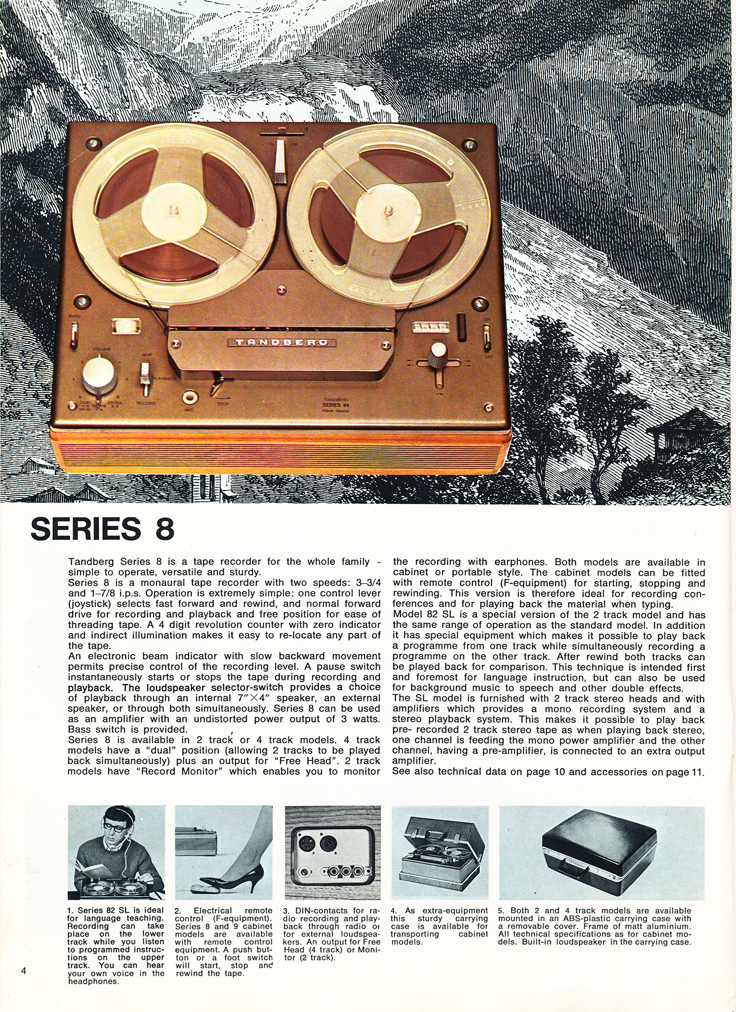
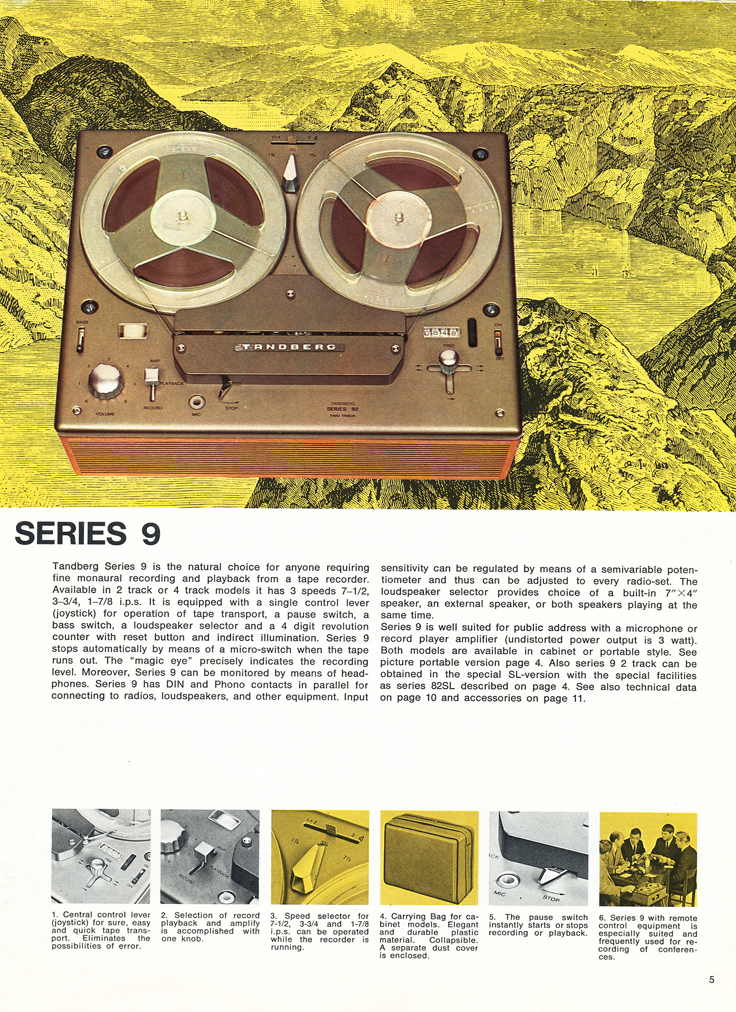
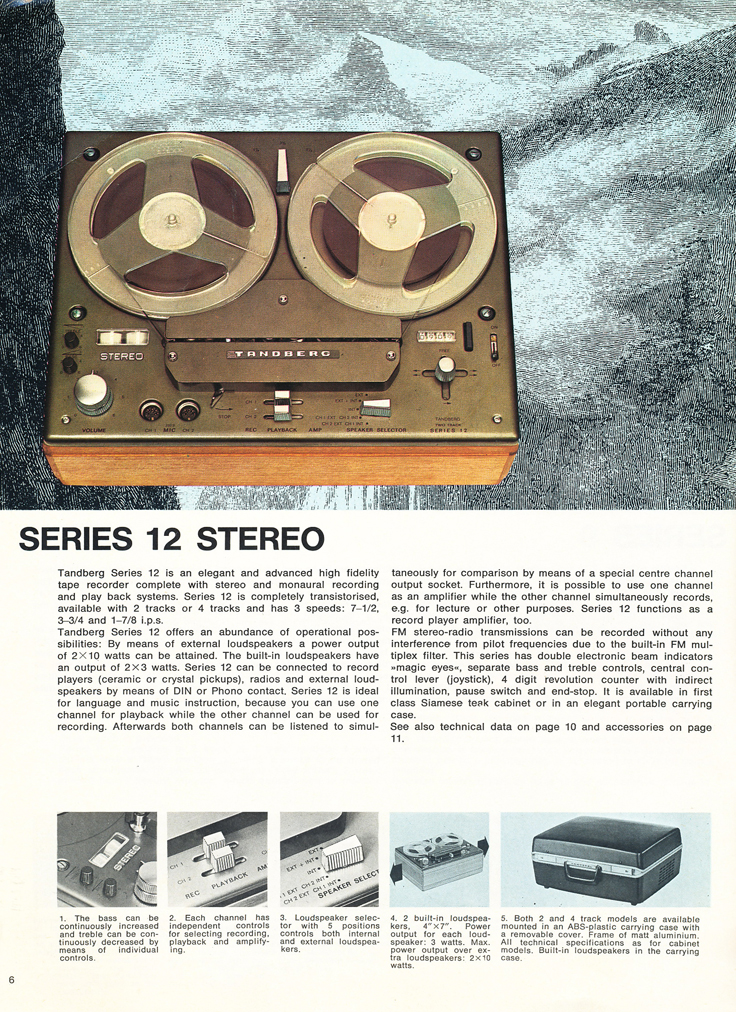
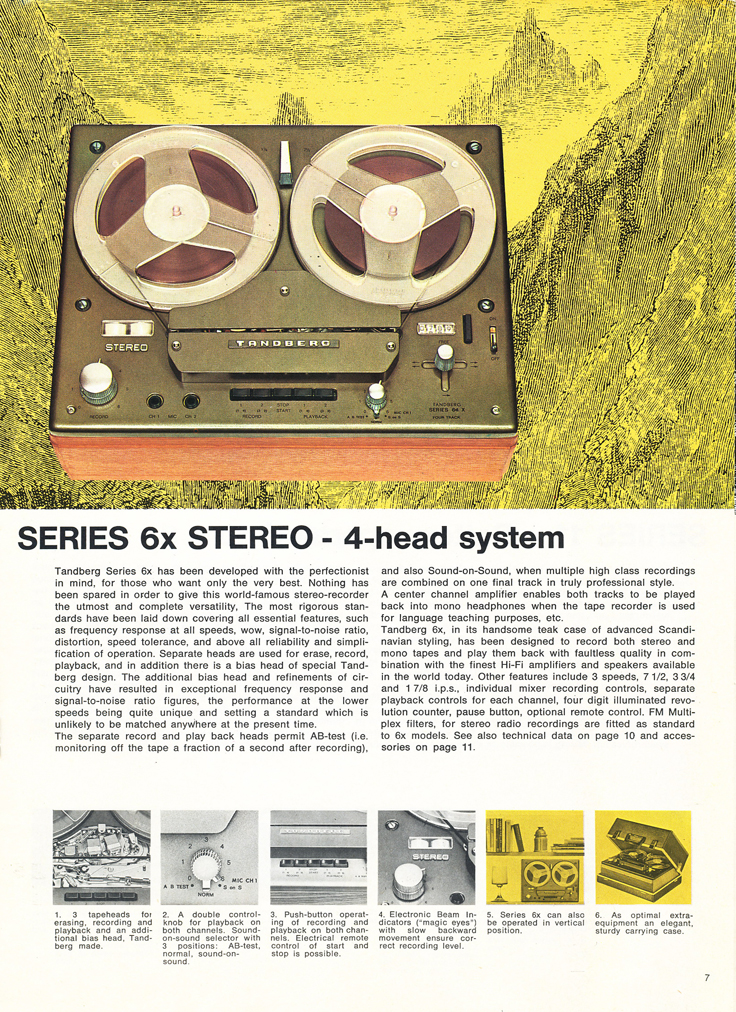
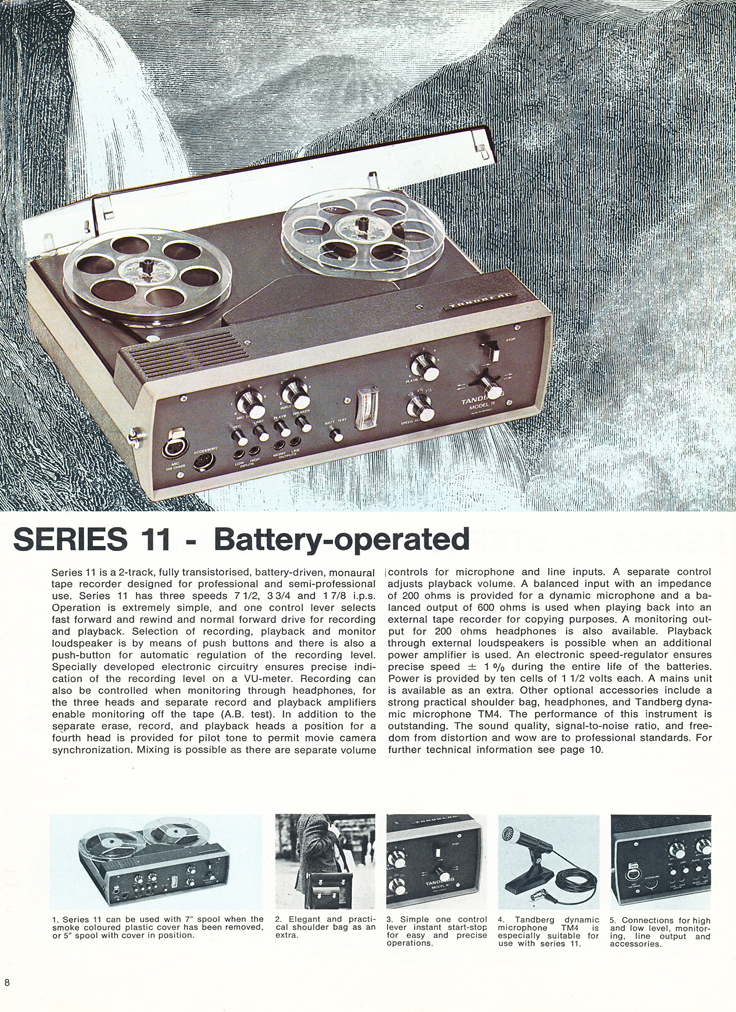
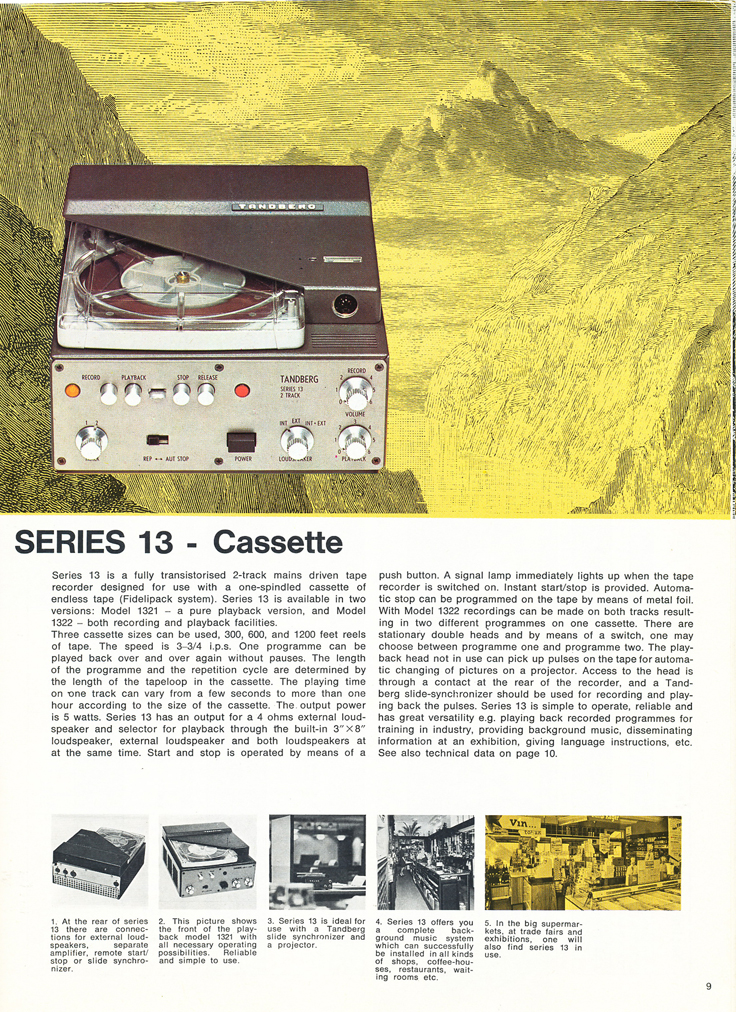
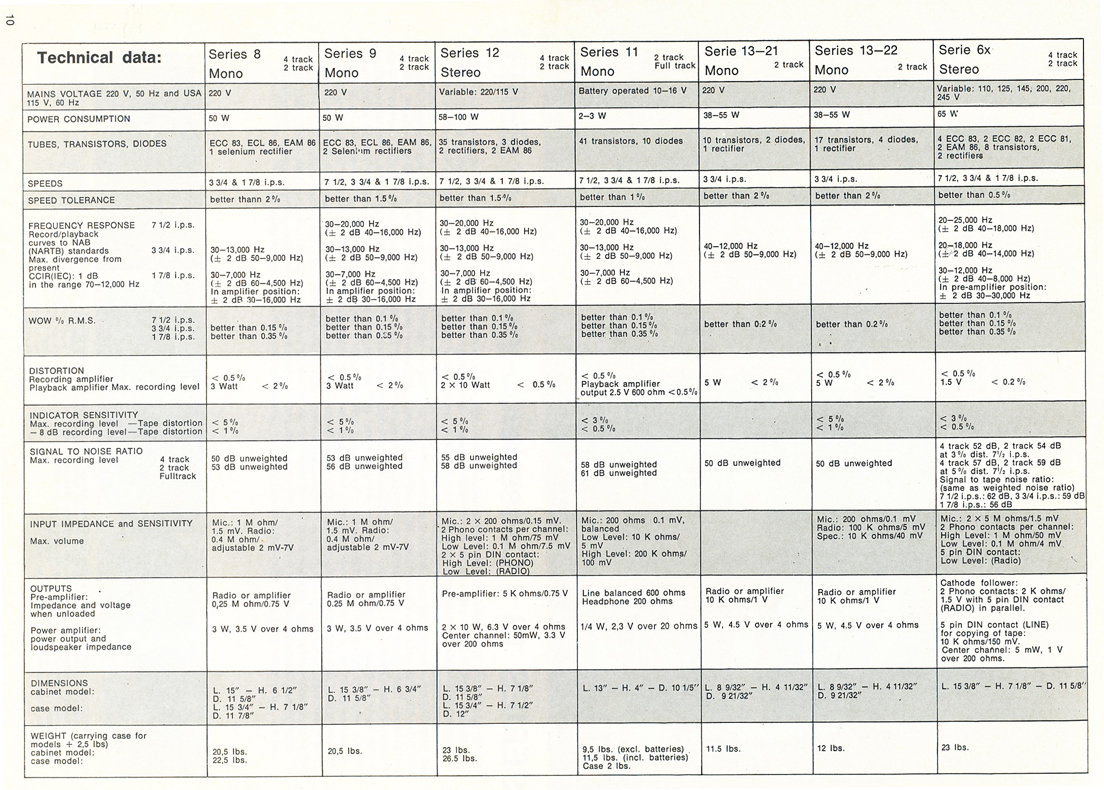
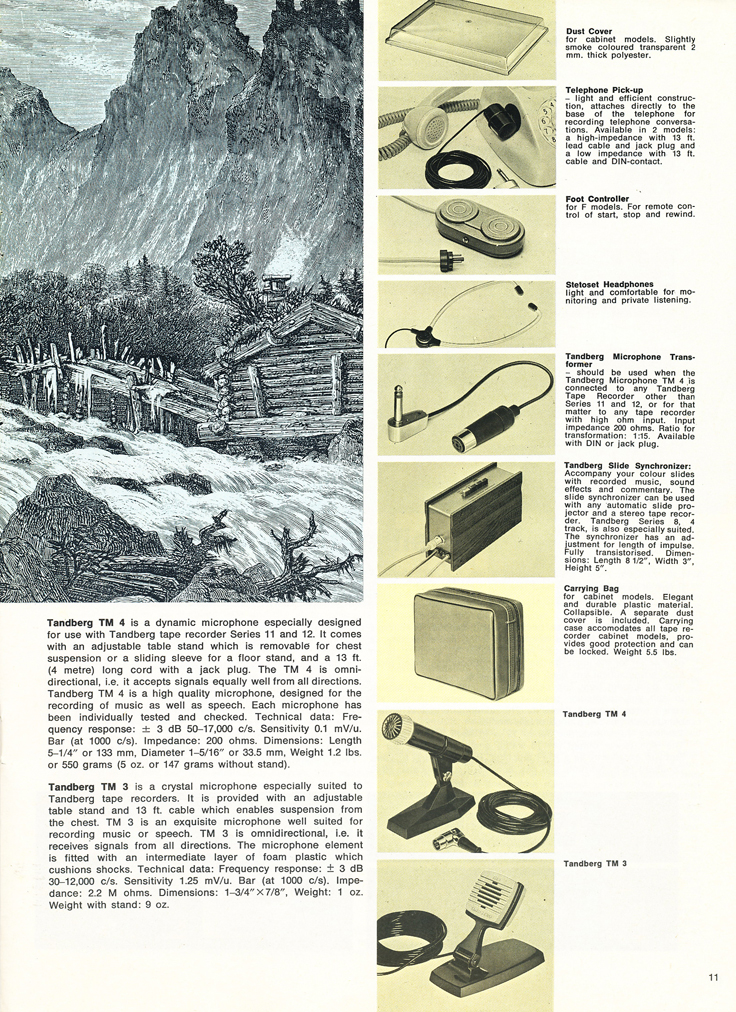
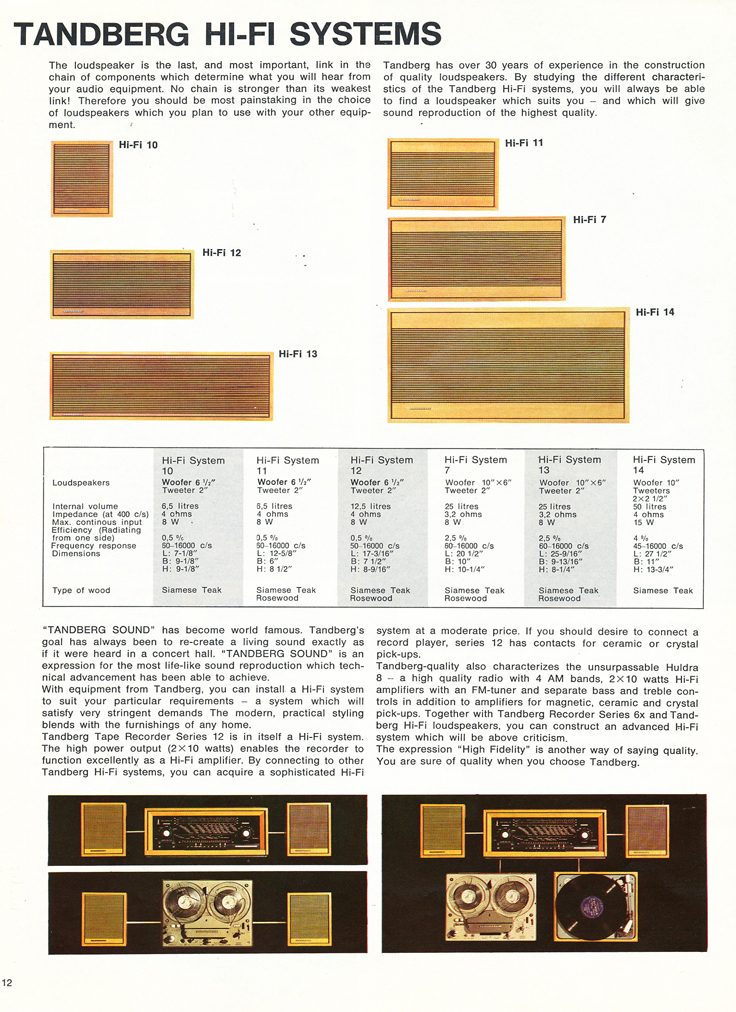
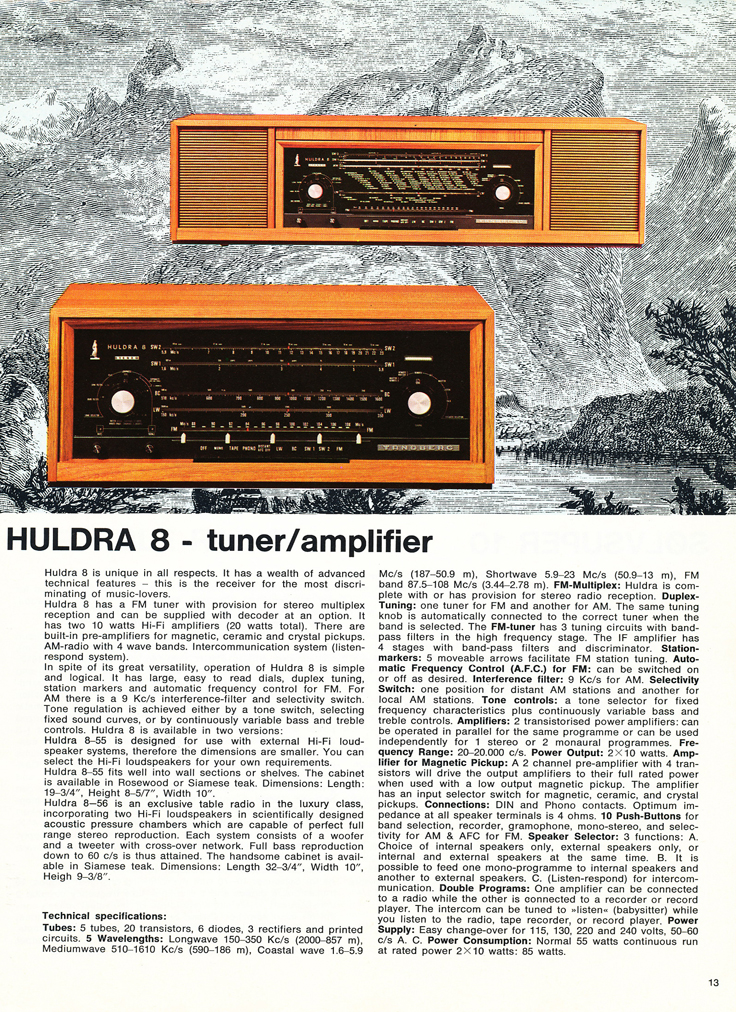
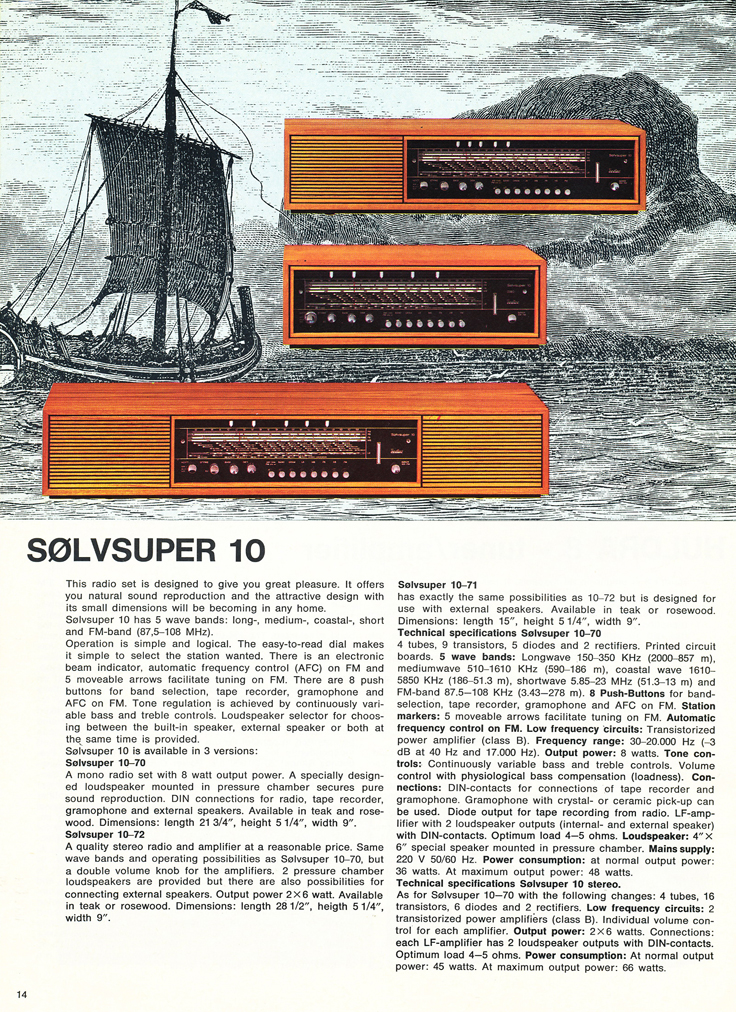
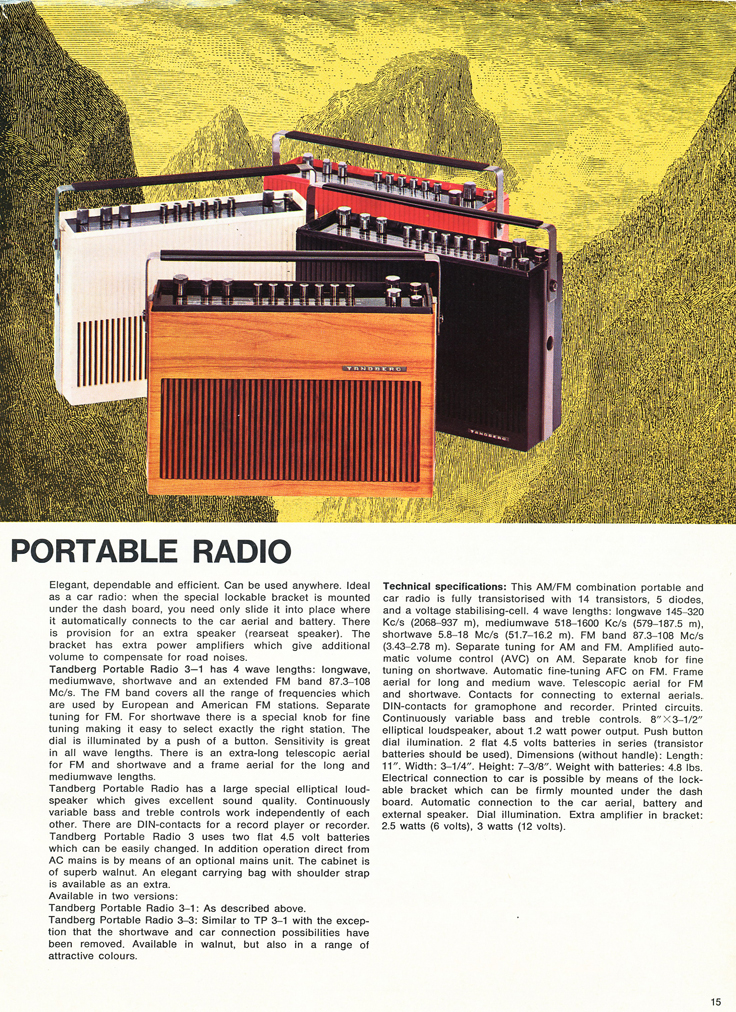
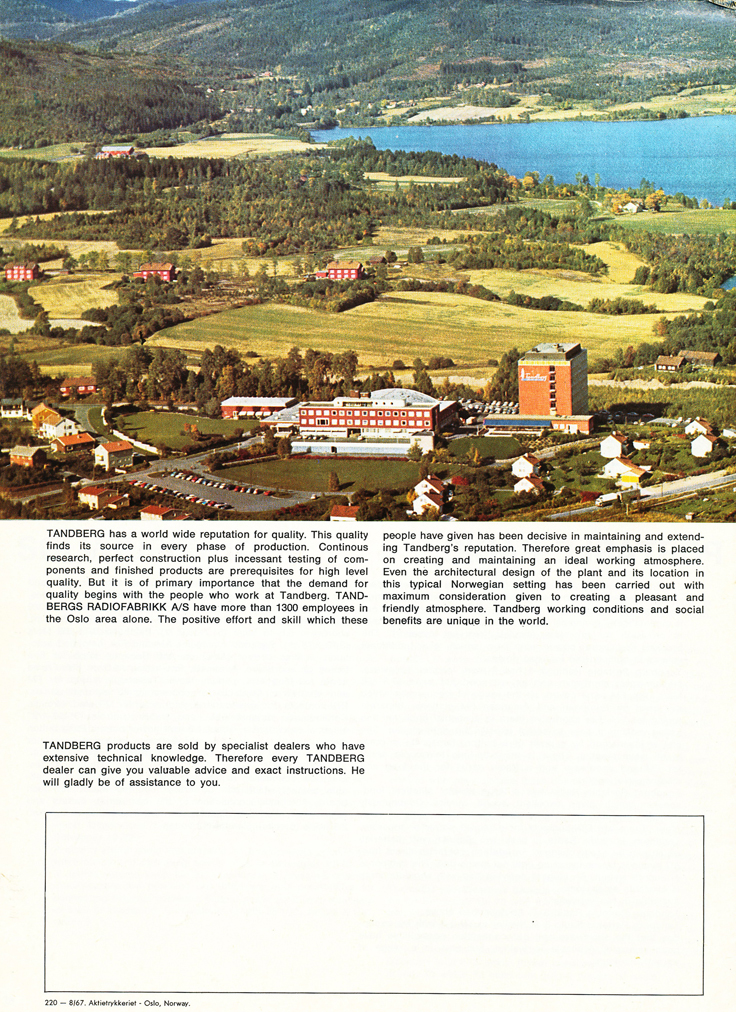
1968
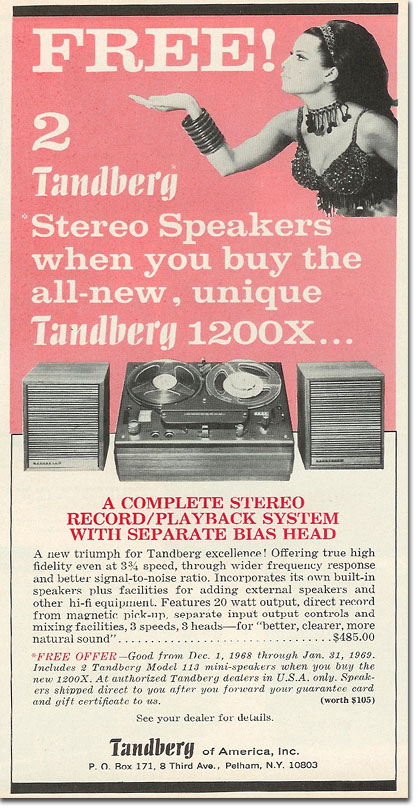
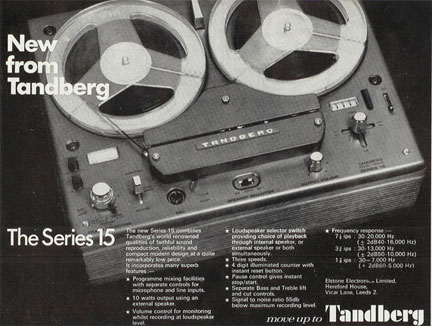
1969
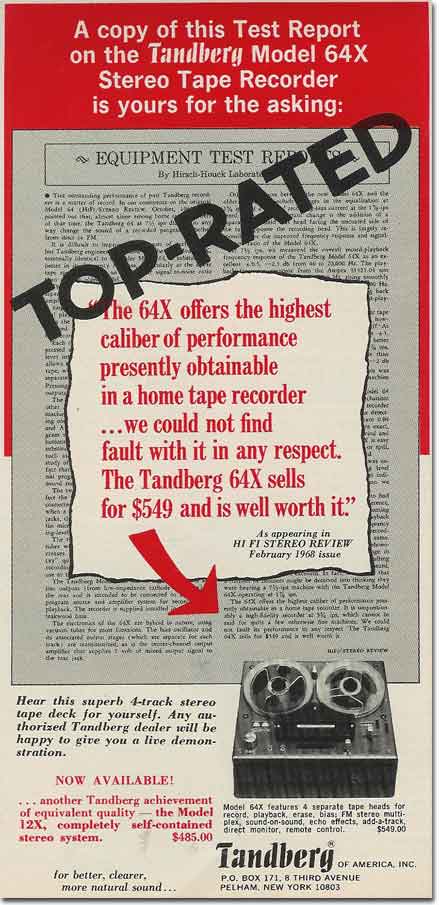
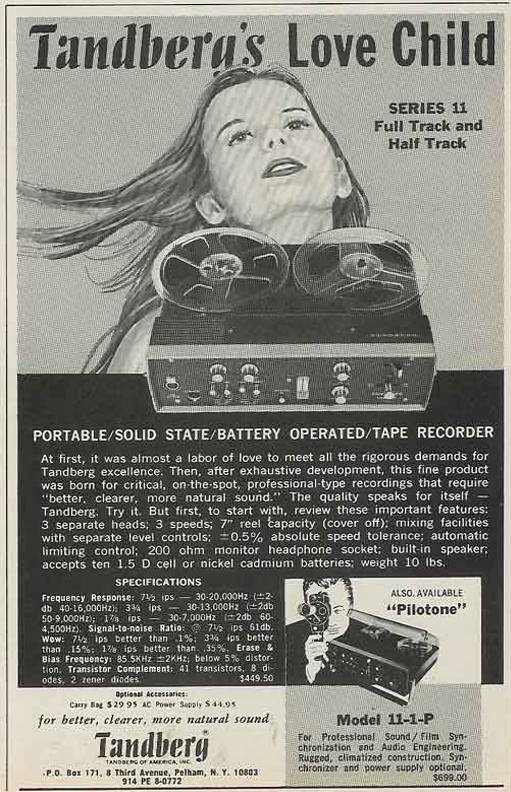
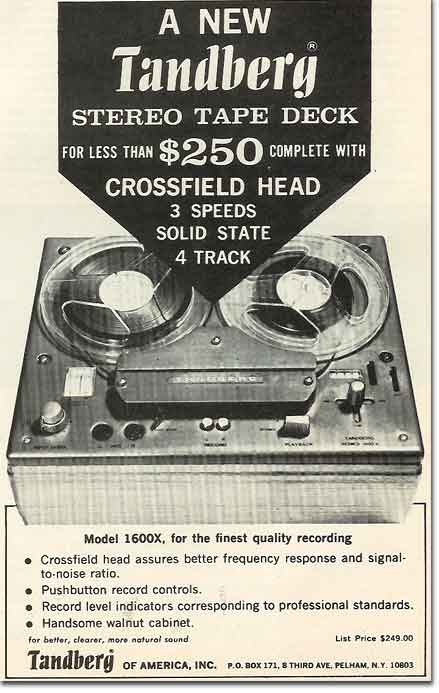
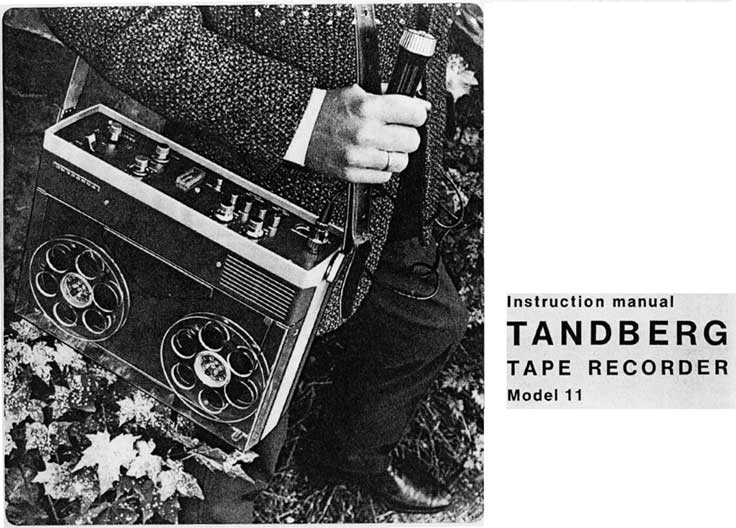
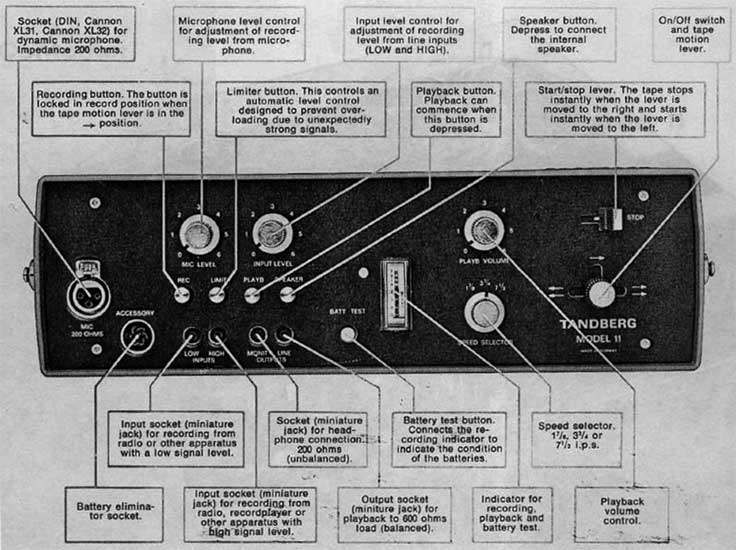
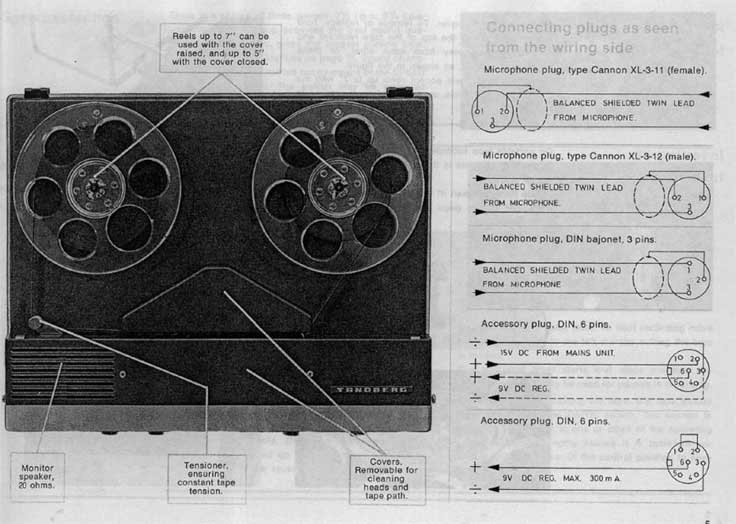
1970
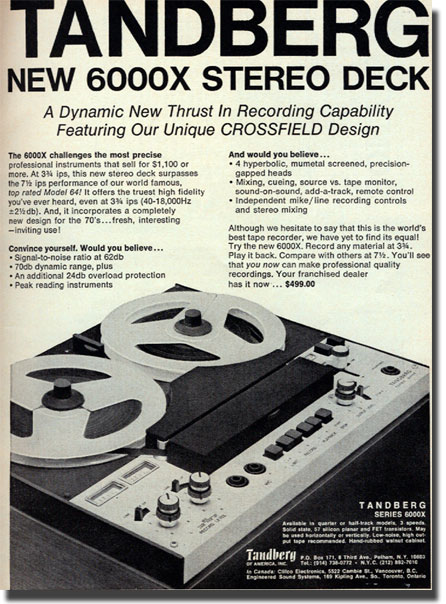
1971
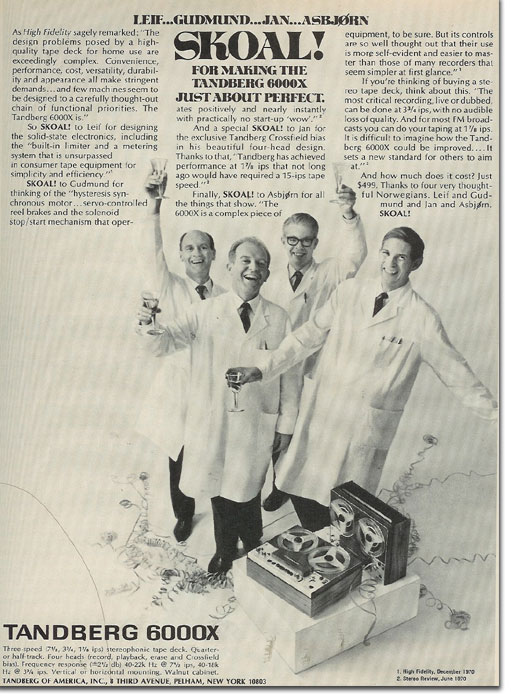
1972
1973
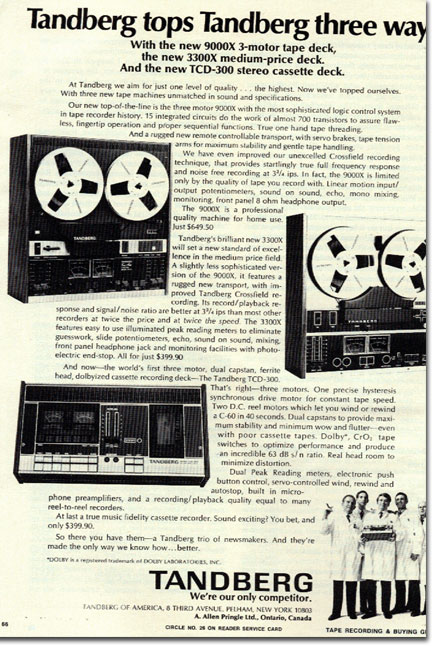
1975
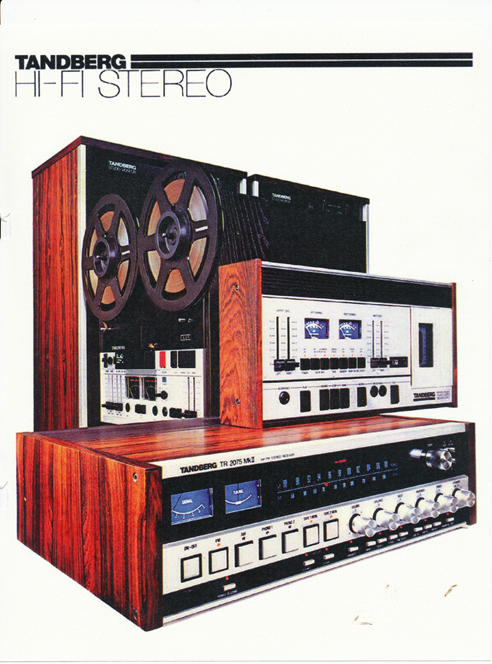
1976
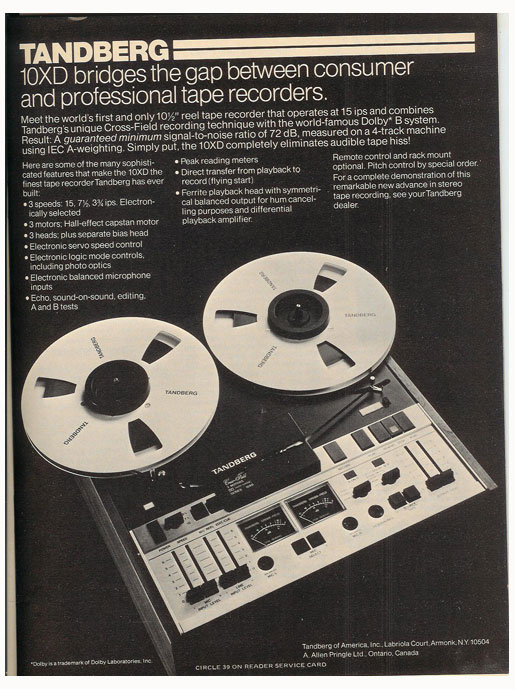
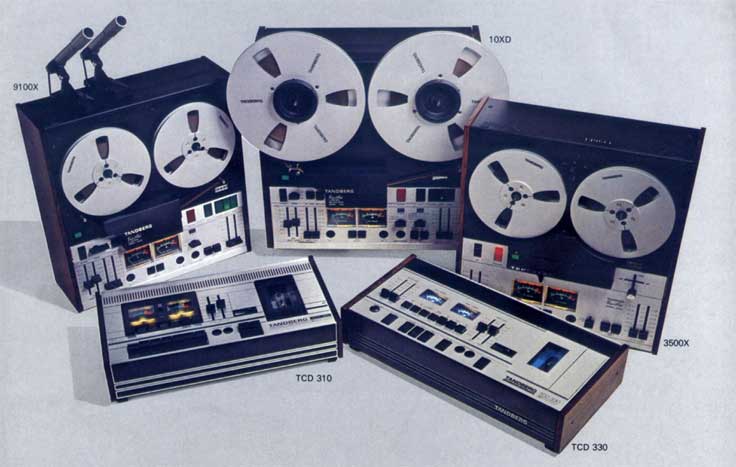
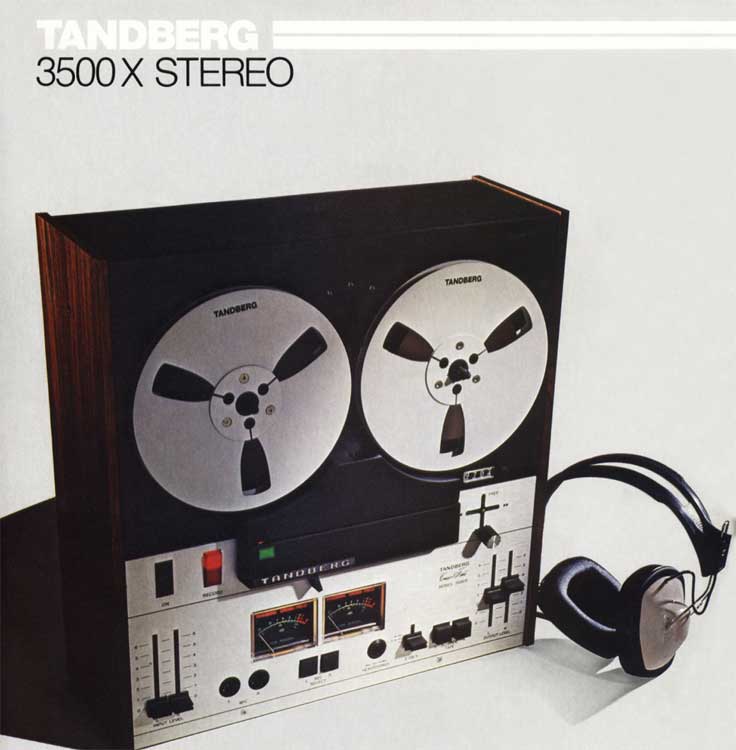
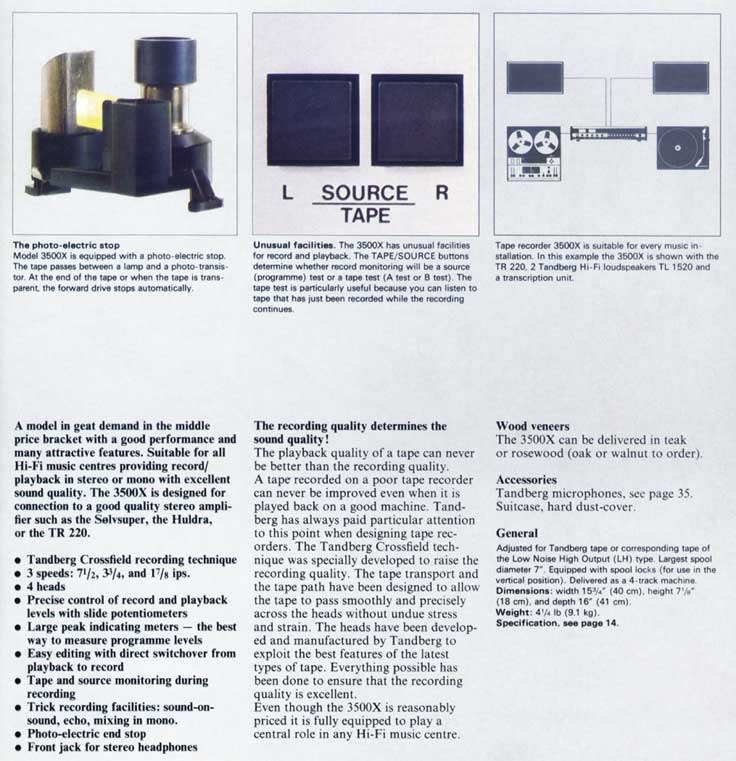
1978
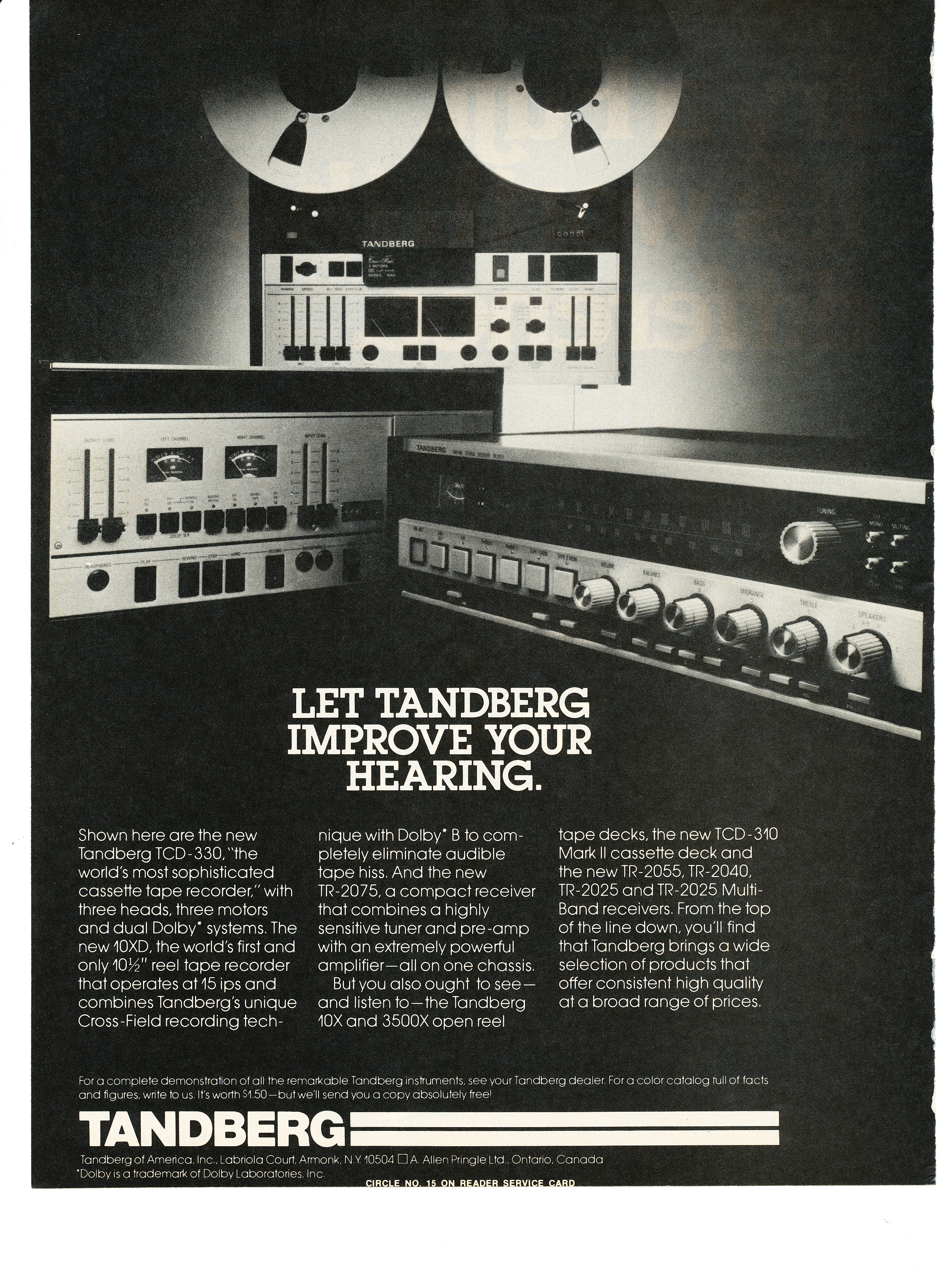
1979
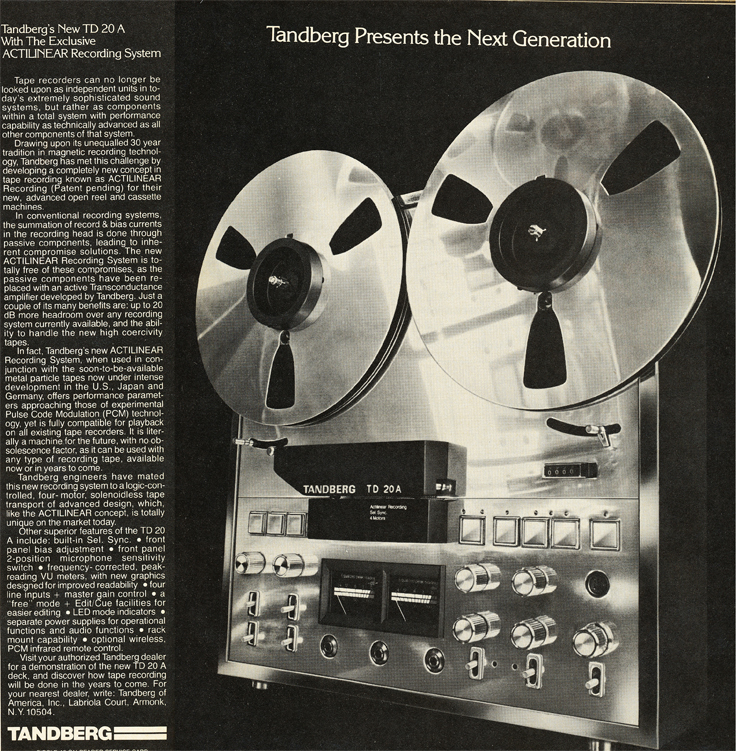
1981

1985
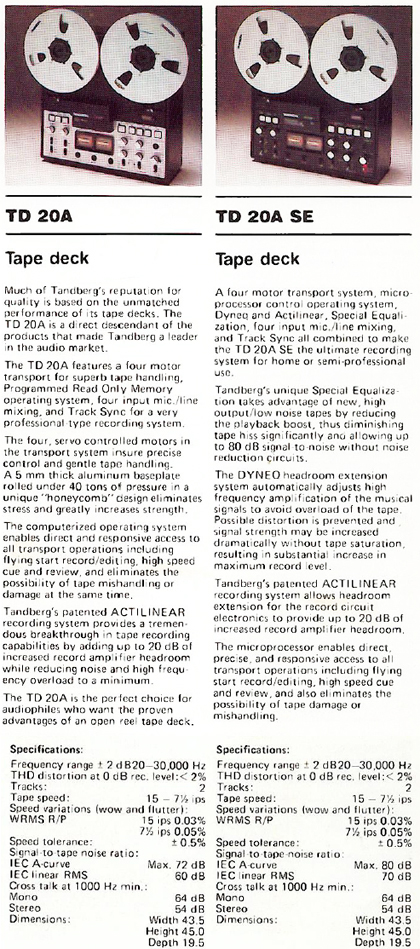
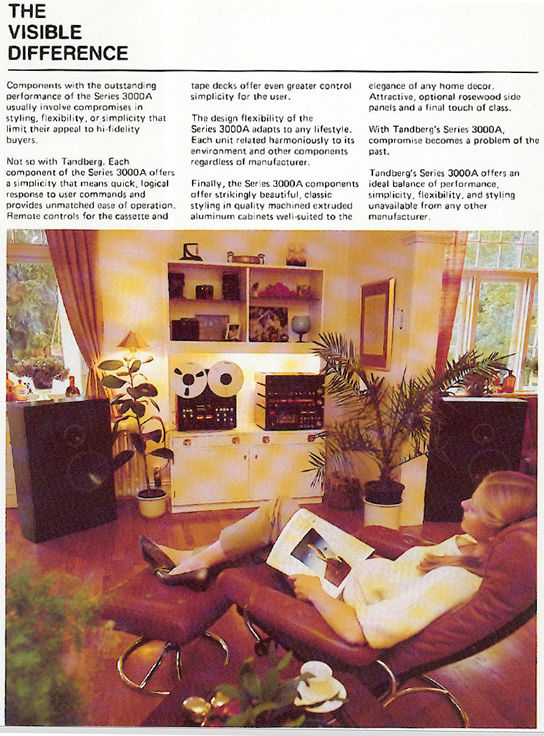
1987
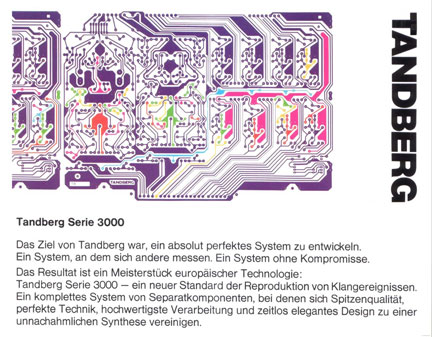 view pdf
view pdf
1994
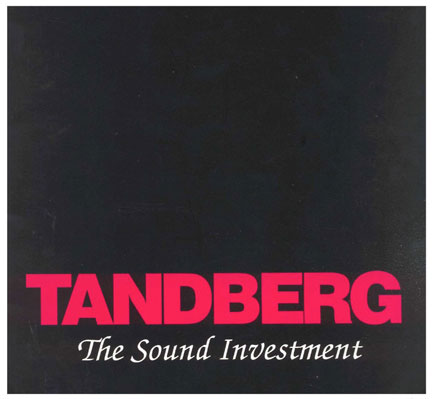 view pdf
view pdf
1996
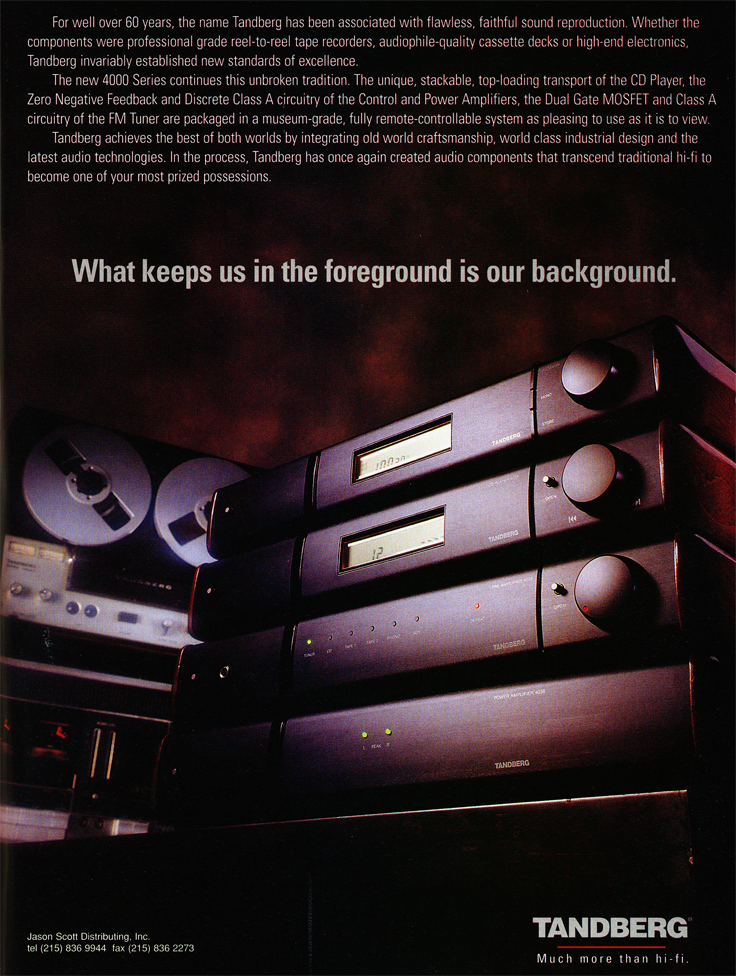
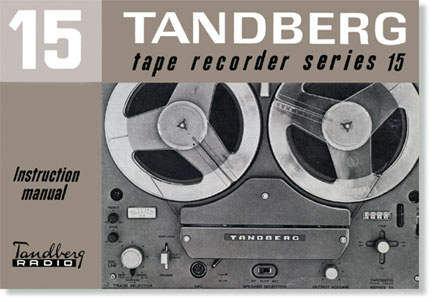
Third Party Photos
We appreciate all photos sent to our museum. We hope to successfully preserve the sound recording history. If we have not credited a photo, we do not know its origin if it was not taken by the contributor. Please let us know if a photo on our site belongs to you and is not credited. We will be happy to give you credit, or remove it if you so choose.
PLEASE NOTE: NONE OF THE ITEMS PICTURED ON OUR MUSEUM WEB SITE ARE FOR SALE!
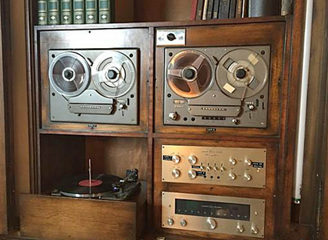
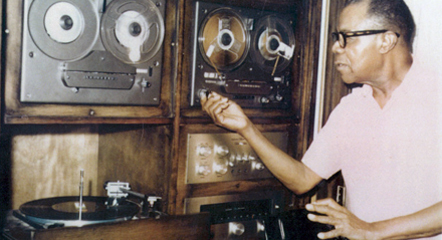

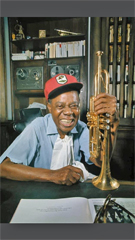
Louis Armstrong
Tandberg recorders in our collection
Year |
Model |
Ad |
Unit in Museum collection |
Specifications |
|
Tandberg Model 6
donated by
Brent Dahl
|
|
|
- Freq Response 40 - 16 kHz
- Signal to Noise 55 db
- Speed 1.875, 3.75 & 7.5 ips
-
Motors 1
- Reels up to 7"
- Timing accuracy 0.15%
- Weight 25 lbs
- Price $498
donated by Brent Dahl
For more, please go to this link |
A reminder that the prices listed are what the item originally sold for in the year it was released.
|
1963 |
Tandberg Model 64
donated by
Curt Thompson |
|
|
- Freq Response 40 - 16 kHz
- Signal to Noise 55 db
- Speed 1.875, 3.75 & 7.5 ips
-
Motors 1
- Reels up to 7"
- Timing accuracy 0.15%
- Weight 25 lbs
- Price $498
For more, please go to this link |
| |
|
|
|
|
- Freq Response 40 - 20 kHz
- Signal to Noise 55 db
- Power Output 20 watts
- Speed 1.875, 3.75 & 7.5 ips
-
Motors 1
- Reels up to 7"
- Timing accuracy 0.15%
- Weight 23 lbs
- Price $498
For more, please go to this link |
A reminder that the prices listed are what the item originally sold for in the year it was released.
|
|
|
|
|
- Freq Response 30 - 26 kHz
- Signal to Noise 64 db
- Speed 1.875, 3.75 & 7.5 ips
-
Motors 1
- Reels up to 7"
- Timing accuracy 0.3%
- Weight 30 lbs
- Price $600
For more, please go to this link |
| |
|
|
|
|
Tandberg 11 dontaed by Dr. Bruce Sommer in Australia
- Freq Response 30 - 18 kHz
- Signal to Noise 64 db
- Speed 1.875, 3.75 & 7.5 ips
-
Motors 1
- Reels up to 7"
- Timing accuracy 0.2%
- Weight 9.5lbs
- Price $449.50 - $699 for the 11 P
For more, please go to this link |
| |
|
Tandberg 100 Instrumentation recorder
|
|
|
- Freq Response 30 - 18 kHz
- Signal to Noise 64 db
- Speed 1.875, 3.75 & 7.5 ips
-
Motors 1
- Reels up to 7"
- Timing accuracy 0.2%
- Weight ? lbs
- Price ?
For more, please go to this link |
| |
| |
Please select a reel tape recorder company from the list below
|
| |
|
| |
|
© 2014 Museum of Magnetic Sound Recording • Webmaster • All pictures and content on this web site are the property of the Museum of Magnetic Sound Recording / reel2reeltexas.com • Photos of items in our collection are available for sale. We do NOT provide copies of ads, nor photos from other sources! All photo work is billed at studio rates and a deposit is required.
|
Go to stories about Tandberg
